Christina Rickman
09-06-2023
North East Housing Initiative uses a Knott Foundation cash flow loan to bridge receivables from Baltimore City’s Department of Housing and Community Development
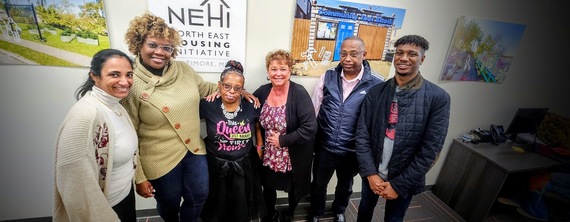
“The cornerstone of a healthy family is housing. You can’t think about your grades as a child if you don’t have a good place to stay. You can’t think about crime and safety if your house is not a safe place,” states Garrick R. Good, Executive Director of North East Housing Initiative (NEHI).
A housing model unique to Baltimore
NEHI is a community land trust dedicated to providing permanently affordable shared equity housing in Baltimore. “A community land trust is community-owned land that is removed from the private real estate market, overseen by a board of directors, and made up of members who live and work within the geographically defined area,” Garrick explains. NEHI buys vacant, abandoned, and foreclosed properties, and using subsidies, rehabs these properties into permanently affordable homes for families earning less than 50% of the area medium income.
If this doesn’t sound like something you’ve seen before, that’s because it isn’t. “Baltimore is the first city to have an affordable housing trust fund. We now have states across the country looking to see if they can replicate it and how,” Garrick says. NEHI is working to educate state and city legislators about the social and fiscal benefits and functions of community land trust organizations. In addition to giving low-income families the opportunity to create and build wealth, the community and city realize the benefit of increased property values.
Delays in government funds
Baltimore City depends on nonprofits like NEHI to provide services ranging from housing and food assistance to rehabilitation, youth mentorship, and job training. Baltimore’s most disenfranchised and vulnerable populations rely on these essential services. However, the City’s contracting and payment process often leaves nonprofits waiting over a year for payment. To avoid a disruption in services, directors like Garrick must find creative solutions to keep the lights on.
This is where the Knott Foundation’s cash flow program can help. Under Garrick’s leadership, NEHI has been the recipient of four cash flow loans from the Knott Foundation. Three of these loans were awarded during the pandemic, helping NEHI to weather exacerbated delays in government payments at the same time that housing insecurity worsened.
When Garrick started at NEHI in 2018, their annual budget was $50,000. Today, it’s $5 million. He has also worked to develop institutional partners who provide services ranging from financial literacy counseling to a tool-library homeowners can borrow from for home repairs. By 2025, his goal is to have 200 homes in their community land trust. “Our goal is to make dreams come true for families that didn’t feel they had the ability to buy a house.”
By Kelly Medinger
07-14-2022
Jesuit Volunteer Corps uses Catholic activities grant to support volunteers and partner agencies in Baltimore
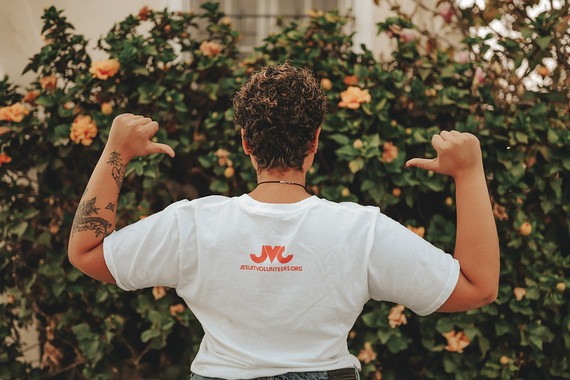 After graduating from Boston College with a degree in business and economics, Codie Perry knew two things: first, he wanted to use his educational background to serve others; and second, he didn’t want to sit in a cubicle all day. Perry applied to Jesuit Volunteer Corps and was placed at St. Vincent de Paul Church in Baltimore City. There, he was charged with running the Church’s outreach ministries in a community experiencing deep poverty.
After graduating from Boston College with a degree in business and economics, Codie Perry knew two things: first, he wanted to use his educational background to serve others; and second, he didn’t want to sit in a cubicle all day. Perry applied to Jesuit Volunteer Corps and was placed at St. Vincent de Paul Church in Baltimore City. There, he was charged with running the Church’s outreach ministries in a community experiencing deep poverty.
“The level of poverty and homelessness was something I had not seen before,” reflects Perry. “It was eye-opening and tough, but also gave my work greater purpose and connected me on a deeper level to the City.”
About Jesuit Volunteer Corps
Over the past 60 years, the Jesuit Volunteer Corps (JVC) has become one of the largest lay, Catholic, full-time volunteer programs in the world. With approximately 200 volunteers each year in 37 cities and 5 countries, Jesuit Volunteers (JVs) put their faith into action through one year of service at nonprofit agencies in high-need communities.
Four core values guide the entire JVC experience: Ignatian spirituality; simple living; community; and social justice. JVs are usually fresh out of college, age 21-25, and enjoy living in community and taking part in professional training and formation, leadership development, and spiritual direction as part of their volunteer experience.
“Orientation reminded me why I chose JVC in the first place. Having a community formed around faith and getting to engage in meaningful conversations was one of the hallmarks of my college experience. Getting to have a community in which I could feel supported in who I am and my faith was very consoling to have as I moved to a new city with new people,” commented one Baltimore JV during orientation week.
Ministering in Baltimore City
Not only is Baltimore the national headquarters of JVC, it is also home to five JVs every year. The Knott Foundation has supported JVC’s presence in Baltimore for over 30 years. The agencies where JVs work in Baltimore have remained consistent for the last several years and include Cristo Rey Jesuit High School, Loyola Early Learning Center, Public Justice Center, and St. Vincent de Paul Beans & Bread/Homeless Outreach.
“It is hard to put the value of the Jesuit Volunteers into a few words!” exclaims Erica Meadows, School Director at Loyola Early Learning Center. “The JVC program is a key part of our school. They are such a positive addition to our team and understand the mission of the school because of their background and experience with Catholic and Jesuit education,” she relays.
As for Codie Perry, he wrapped up his work at St. Vincent de Paul Church five years ago, then returned to his hometown in Massachusetts. Perry recently came back to Baltimore to join the team at Johns Hopkins’ Office of Economic Development. There, he helps grow the small business community and promotes local goods and talent. “Something about my year of service drew me back to Baltimore,” he admits. “I was inspired by how many people and organizations are dedicated to bringing justice and peace to this community, and I wanted to help carry that mantle forward in my own work.”
By Kelly Medinger
03-10-2022
Walters Art Museum uses arts & humanities grant to restore a rare statue of St. Michael the Archangel
 “Conservation and repair of our collective cultural heritage is key to our understanding of world history and the universal human need to create,” observes Julie Lauffenburger, Director of Conservation, Collections, and Technical Research. “Works of art that have been preserved and shared with the public help bring history to life and foster conversation about world events, religion, culture, and life in periods beyond our own.”
“Conservation and repair of our collective cultural heritage is key to our understanding of world history and the universal human need to create,” observes Julie Lauffenburger, Director of Conservation, Collections, and Technical Research. “Works of art that have been preserved and shared with the public help bring history to life and foster conversation about world events, religion, culture, and life in periods beyond our own.”
About the Walters Art Museum
Established in 1934, the mission of the Walters Art Museum is to bring art and people together for enjoyment, discovery, and learning.
Located in Baltimore’s historic Mount Vernon neighborhood, the Walters offers free admission to all visitors. The museum’s campus includes five buildings and 36,000 art objects from the Mediterranean, Africa, East Asia, Europe, the Middle East, and the Americas. By collecting, preserving, and interpreting art, the Walter’s creates a space for people of every background to engage in dialogue and be touched by art.
About St. Michael the Archangel
St. Michael is an archangel in Judaism, Christianity, and Islam. In Roman Catholic tradition, St. Michael is the guardian of the Church and the leader of heaven’s forces in their triumph over the powers of evil. He is the patron saint of soldiers, police officers, and doctors.
The Walters collection includes a rare 17th-century ivory sculpture of St. Michael the Archangel, which was not on display for several decades due to needed restoration. The Knott Foundation helped fund conservation treatment that repaired his broken wings and consolidated paint and gilding loss on the statue.
Today, Michael stands nearly four feet tall, with long hair, wings, pleated skirt, sash, and boots. He holds a sword above his head as he stands on the body of the devil. The size and detail of the St. Michael statue are rare, and it would have been an expensive and high value sculpture to produce.
A Story of Global Trade
When it came into the collection in the early part of the 20th century, the St. Michael statue was believed to have been made in Italy during the Renaissance period. However, further research revealed his true origins.
“This striking 17th century sculpture was made in Manilla from African elephant tusks for a church in Mexico,” reveals Katarina Ziegler, Director of Institutional Giving & Government Affairs. It was created as a devotional statue for a Mexican church, by an artisan in the Philippines, with material from Africa. “What a remarkable story of global exchange of ideas, art, crafts, materials, and faiths!” she exclaims.
The St. Michael statue is a physical embodiment of early international trade routes and the spread of Catholic iconography and beliefs throughout the world. Its history is a marriage of three continents, dating back some 400 years. It is a global treasure in our own local art museum.
By Kelly Medinger
10-27-2021
The Pro Bono Counseling Project uses health care grant to connect caregivers to donated therapy sessions
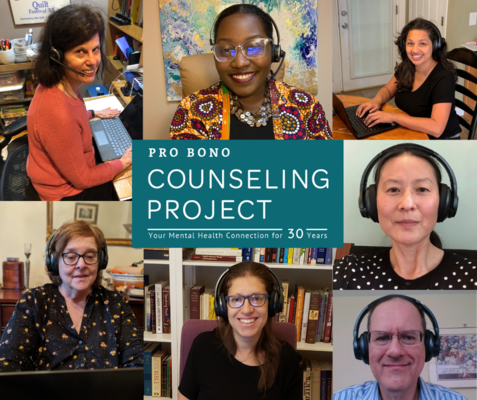 When 30-year old Jasmine moved home to take care of her father with cancer and mother with depression and hoarding issues, she needed someone to help her through the grief, pain, and psychological stress of becoming a caregiver. Enter Pro Bono Counseling Project.
When 30-year old Jasmine moved home to take care of her father with cancer and mother with depression and hoarding issues, she needed someone to help her through the grief, pain, and psychological stress of becoming a caregiver. Enter Pro Bono Counseling Project.
About Pro Bono Counseling Project
Pro Bono Counseling Project (PBCP) connects individuals, couples, and families living in Maryland to free mental health services, whether they are experiencing stress, anxiety, sadness, grief, a life transition, or relationship issue.
“We really work with folks to make a good match between patient and therapist,” describes Amy Greensfelder, Executive Director. “This fit is the most important predictor of success in therapy. We interview people up front to find out what they’re looking for in a therapist, and we use our extensive network of clinicians to find the best match.”
Founded over 30 years ago, PBCP has helped over 30,000 Marylanders find volunteer counselors and receive the therapy they otherwise could not afford. Over 850 volunteer clinicians work with PBCP’s clients to provide thousands of hours of donated therapy sessions each year.
Caring for Caregivers
PBCP’s Caring for Caregivers program helps people cope with the psychological stress of caring for a loved one with high medical needs or a chronic condition.
“Caregiving is often an unrecognized, misunderstood, and neglected issue in our community. Even caregivers themselves may not identify with the term. Because the vast majority of caregivers are loved ones – a spouse, a parent, a child, or a family member – they might classify ‘caregiver’ as someone who does the job full-time, or is a paid professional,” mentions Greensfelder
Meanwhile, the competing priorities caregivers face, such as work, family, and medical management, often block their ability to take care of their own mental health needs. The Caring for Caregivers program helps these to find the space to “refill their cup,” as Greensfelder puts it.
The Knott Foundation supported PBCP’s Caring for Caregivers program with a grant in 2020. That support enabled PBCP to train more than 40 clinicians in caregiver mental health practices, to answer 41 phone calls from people experiencing caregiver stress, and to serve 30 people with 300 hours of donated therapy – equating to $45,000 of donated care.
Recognizing the Need
Oftentimes people focus on those with the highest need – the parent who just received a cancer diagnosis, the grandparent who is aging in place, or the child who is born with a chronic health condition. While this focus is necessary, it can gloss over the needs of the caregivers.
“The biggest thing is just recognizing these needs in our community and being there when our friends and loved ones step into the role of caregiver,” reflects Greensfelder. “It’s important to make sure people who are supporting the needs of others also support themselves.”
By Kelly Medinger
10-27-2021
Archdiocese of Baltimore uses education grant to build the new Mother Mary Lange Catholic School in Baltimore City
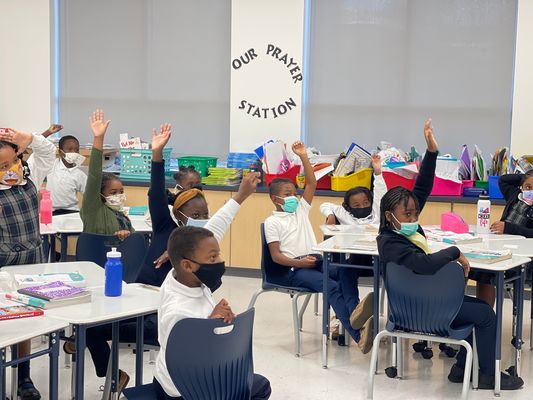 A new, 65,000 square foot school stands proudly on Martin Luther King Jr. Boulevard. A large cross illuminates three stories of windows above the front entrance, which first welcomed students on August 30, 2021.
A new, 65,000 square foot school stands proudly on Martin Luther King Jr. Boulevard. A large cross illuminates three stories of windows above the front entrance, which first welcomed students on August 30, 2021.
Honoring a saintly woman
Mother Mary Elizabeth Lange moved to Baltimore from Cuba. She opened a school for girls of color in her home in Fells Point, which became the only provider of Catholic education to black children in Baltimore during the 19th Century. She also founded the Oblate Sisters of Providence, the first religious order for women of African descent in the United States, and is a candidate for sainthood.
Every floor of the school has an image of Mother Mary Lange.
During the ribbon cutting and blessing of the new school, eighth-grader Jaylah Golder announced to the crowd: “I intend to follow in the footsteps of Mother Lange by leading others to do good and try my best to stand up for those who aren’t big enough to stand up for themselves.”
Enrolling students in a new tradition
Mother Mary Lange Catholic School began its inaugural year with over 400 children in grades pre-K through 8. The students hail from 70 zip codes. Only approximately 20% are Catholic.
“This is not just a job, it’s a ministry,” explains Alisha Jordan, Principal. She has involved the kids in all aspects of the school, from picking their uniforms, to selecting a mascot – the Mother Mary Lange Catholic School Tigers. They also planted two time capsules in front of the school to commemorate its opening and preserve the legacy of the two schools that were consolidated into Mother Mary Lange: the former Holy Angels Catholic School and Saints James and John Catholic School.
Building amenities and partnerships to serve the community
The Knott Foundation contributed to the capital campaign to build the new school.
Once a vacant lot in the City, Mother Mary Lange is now a model of top-notch amenities: fully-equipped art and science labs; a spacious library; a cafeteria and gymnasium with a stage for student productions; a turf field; two playgrounds; and a chapel. “We are the first archdiocesan elementary school in Baltimore to have a tabernacle in the chapel,” comments Jordan. “The Archbishop is very proud of that.”
The school’s health suite also features a partnership with University of Maryland Children’s Hospital, where doctors offer physicals for students and the school nurse has access to a telehealth line during the day. A private health suite, hands-free plumbing, and sanitary devices are new features that were incorporated during construction, which further enhance the school’s focus on student health.
“This is a loving, secure, Catholic community,” concludes Jordan, “and we look forward to becoming part of the social fabric of this neighborhood for many years to come.”
By Kelly Medinger
07-07-2021
St. Veronica’s Church uses Catholic Activities grant to replace their roof
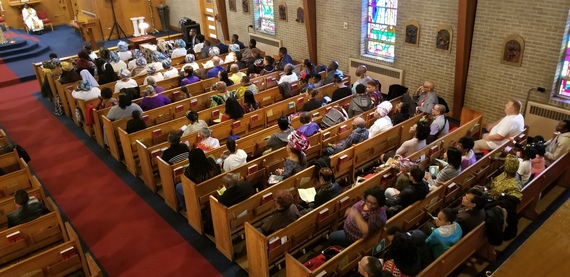 A clean red brick façade with a statue of St. Veronica helping Jesus, surrounded by manicured green grass and shrubbery, stands proudly on Cherry Hill Road in Baltimore.
A clean red brick façade with a statue of St. Veronica helping Jesus, surrounded by manicured green grass and shrubbery, stands proudly on Cherry Hill Road in Baltimore.
About St. Veronica’s
For over 75 years, St. Veronica’s Catholic Congregation has been a community of worship in the Cherry Hill neighborhood of Baltimore City. The Church was established by the Joesephites, a religious community of Catholic priests and brothers, committed to serving the African American community. Today, it serves 230 registered families and attracts parishioners from Cherry Hill, West Port, Curtis Bay, Brooklyn, and Port Covington.
St. Veronica’s is a small church with no paid staff. Nearly half of the congregation volunteers in management, ministry, and outreach services. “People always want to come forth and do something for our parish, and that gives me great joy,” comments Fr. Stephen Ositimehin, Pastor. “Our church doesn’t belong to any one person, it belongs to all of us,” he shares.
Raising the Roof
Realizing that the original roof installed in 1954 needed to be replaced, the Church organized a “Raise the Roof” campaign to raise money for a new roof. With support from parishioners, alumni, their sister parish (Our Lady of Perpetual Help in Ellicott City), the Knott Foundation, and others connected to the mission, St. Veronica’s raised over $150,000 for the project.
“Everybody who pledged to the campaign ended up paying more than they pledged,” shares Cathy McClain, Church Secretary. “When other parishes were struggling to make ends meet during the COVID pandemic, our parish was lucky,” she explains. Some people donated their entire economic stimulus check to the campaign, while others gave what they would have spent on their commute to work, since they were working virtually.
Even the roofing contractor managed to save money by pairing St. Veronica’s job with another one nearby, which enabled them to purchase the necessary lumber at a bulk rate. This was extremely helpful, as lumber prices increased greatly during the pandemic.
Giving Back
Often described as a leader and stabilizing force in the community, St. Veronica’s provides much more than mass, sacraments, and Catholic fellowship. A food pantry, thrift store, healthy cooking classes, summer camp, eviction prevention services, and holiday outreach to families in need are just some of the ways the parish helps the broader community.
“It’s really hard to preach to someone if they’re hungry,” says McClain. “We realize we have to give back in order to receive. Since St. Veronica’s was established, we have always felt it was our responsibility to care for the corporal and spiritual needs of our community.”
By Kelly Medinger
07-07-2021
Franciscan Center uses human services grant to create more healthy meals to feed the hungry
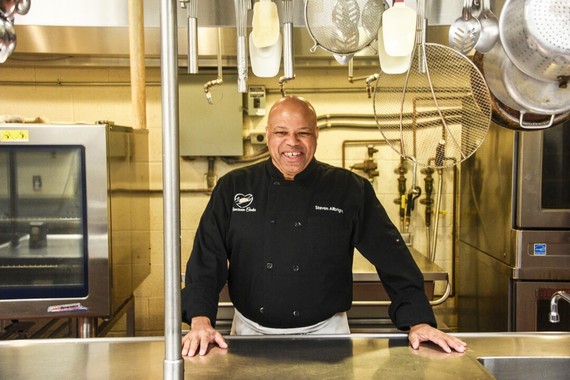 In Baltimore City, a group of red brick row houses sit on West 23rd Street where, in 1968, Sister Irene Marshiano, O.S.F. opened an emergency food and clothing center when local residents told her that’s what they needed most.
In Baltimore City, a group of red brick row houses sit on West 23rd Street where, in 1968, Sister Irene Marshiano, O.S.F. opened an emergency food and clothing center when local residents told her that’s what they needed most.
Now more than 50 years later, the Franciscan Center remains a ministry of the Sisters of St. Francis of Assisi and offers a continuum of care to local people in need – including food, clothing, emergency health services, counseling, and technology training to help clients become as self-sufficient as possible.
A key ingredient for success
A hallmark of the Franciscan Center’s programming is daily hot lunch service. As a longtime supporter of the Center, the Knott Foundation recently made a grant to support the Center’s new culinary director who helps lead their dining services program.
“We believed that a trained culinary chef could change the culture of the Franciscan Center’s dining services, by creating a new way of feeding and a new way of cooking for our patrons,” shares Jeff Griffin, Executive Director of the Franciscan Center.
Enter Chef Steve Allbright, a two-time graduate of Stratford University with an Advanced Culinary Degree and Baking & Pastry Arts Degree, a decorated US Navy Veteran, and an experienced chef at multiple high-end restaurants.
Creating healthier meals
“As much as I appreciate casseroles, I believe cooks are supposed to cook,” proclaims Chef Allbright. In his first year at the Franciscan Center, he partnered with four farms in and around Baltimore to increase the amount of fresh food and vegetables coming into the Center. He also started teaching people how to make healthy and delicious meals with donated provisions.
“Folks eat with their eyes, so we plate what we’re going to serve every day and post it to our Facebook Page,” says Chef Allbright.
By changing the products they were getting and where they were getting them from, the Franciscan Center dramatically reduced its food budget from $125,000 per year to $75,000 per year. They also made other nutritional changes, like serving water instead of a sugary lemon drink traditionally offered to the hot lunch patrons. Then COVID hit.
Expanding during the pandemic
“We’ve just about tripled the amount of food we typically serve during the pandemic,” explains Griffin. The Center changed its model from only serving food at the Center, to adding a meal delivery system, going to apartment complex and homeless encampments throughout Baltimore City.
“By going to where the people are and bringing them healthy meals, we have also created some very helpful conversations and opportunities for our patrons,” comments Griffin. “We are able to help them with more than just food.”
By Kelly Medinger
01-06-2021
HASA uses health care grant to provide charitable care services to children and adults in Maryland
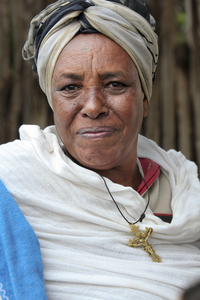 A 65-year-old woman named Dolores was referred to HASA (formerly known as the Hearing and Speech Agency) by her ENT for hearing aids. She had profound hearing loss. Even though her family knew she needed hearing aids, they could not afford the cost. They came to HASA for help.
A 65-year-old woman named Dolores was referred to HASA (formerly known as the Hearing and Speech Agency) by her ENT for hearing aids. She had profound hearing loss. Even though her family knew she needed hearing aids, they could not afford the cost. They came to HASA for help.
About HASA
Founded in 1926, HASA’s mission is to connect people to their worlds. Recognizing the critical role of communication in life, HASA provides clinical, educational, and American Sign Language (ASL) interpretation services to children and adults with the vision “to help them understand and be understood.”
“HASA is Baltimore’s best resource to support individuals with communication differences and disorders like autism, developmental language disorder, and hearing loss,” explains Erin K. Stauder, CEO of HASA. “Left untreated, these conditions can have wide-ranging devastating effects on people’s lives, causing academic problems, social difficulties, and challenges in the workplace.”
Charitable Care
“We never turn anyone away due to their inability to pay,” states Ilana Glazer, External Relations Director at HASA. In 2020, this meant that nearly 1,000 people received assistance from the HASA Charitable Care Fund, supported with a grant from the Knott Foundation, to access comprehensive audiology, speech-language pathology, and occupational therapy.
The importance of charitable care has heightened with insurance coverage challenges. For example, stuttering treatment is not covered when it occurs spontaneously during childhood (which it most often does), and under Maryland law, hearing aids are provided for those on Medicaid, but not others who might not be able to afford them (like Dolores).
A Positive Outcome
At HASA, Dolores was fitted for hearing aids at a reduced fee. At her two-week follow-up appointment, she was found smiling and laughing in the clinic waiting room, heavily engaged in a conversation with her son and daughter-in-law. Her family reports that they were not even aware of how much she was missing in life until she got them.
“HASA’s Charitable Care program helps hundreds of people like Dolores to afford the services they need every year, preventing the serious long-term effects of untreated communication challenges,” states Glazer. Indeed, Dolores’ experience of reconnecting with family and friends is just one example of how important HASA’s mission and services are.
“Effective commination is vital to the health of individuals and communities,” concludes Stauder.
By Kelly Medinger
10-16-2020
Oblate Sisters of Providence use Catholic activities grant to replace the roof on their Chapel and Sacred Heart Hall
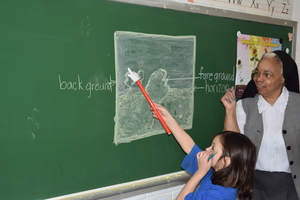 Sister Rita Michelle Proctor, OSP, serves as the Superior General of the Oblate Sisters of Providence, an order that she has been a part of for more than 50 years. “I’ve come to understand that God calls us to different walks of life. I felt called to religious life with the Oblates. I remember being attracted by their sense of genuineness and hospitality,” she reflects.
Sister Rita Michelle Proctor, OSP, serves as the Superior General of the Oblate Sisters of Providence, an order that she has been a part of for more than 50 years. “I’ve come to understand that God calls us to different walks of life. I felt called to religious life with the Oblates. I remember being attracted by their sense of genuineness and hospitality,” she reflects.
About the Oblate Sisters of Providence
Formed in 1829, the Oblate Sisters of Providence are the first religious order in the Roman Catholic Church founded by women of African descent. In the early years, the Sisters educated youth and provided a home for orphans. Slaves who had been purchased and freed were educated and, at times, admitted into the congregation.
Mother Mary Lange is the Order’s Foundress and was born in Santiago de Cuba in 1784. Despite the racial hardship around her, Mother Lange began St. Frances Academy, a Catholic school in Baltimore City, and attracted African American women to join her as servants of God.
The order currently consists of approximately 80 Sisters in parishes and schools located in Maryland, New York, Florida, and Costa Rica. Their Motherhouse is in the Baltimore area, where almost 40 Sisters reside. “Our Sisters struggled to build this house,” says Sister Rita Michelle. “They sold aprons to build it. We are proud of that heritage and are glad to have a place to call home.”
Many supporters
The Knott Foundation awarded Oblates a challenge grant to replace the roof on their Chapel and Sacred Heart Hall, which are located at the center of the Motherhouse and serve the Sisters and community on a daily basis. The Sisters more than doubled the Foundation’s grant by raising money from the Bunting Family Foundation, the Mother Mary Lange Guild, and the Sisters themselves.
“The roof was leaking. We knew it would take a miracle to raise the money to fix it,” states Sister Rita Michelle. She laughs remembering the Order’s 190th anniversary celebration where the Sisters creatively placed potted plants in various locations to catch the drips of water.
A path to sainthood
“I would describe Mother Lange as a woman of color, deep faith, great courage, and a desire to serve God’s people,” says Sister Rita Michelle. “She trusted in God’s providential care, a trust that has permeated our community for 191 years now. She also had an inner joy that could only come from God.”
As testament to that great faith, trust, and joy, Mother Mary Lange is being considered for sainthood. Her life’s journey has been documented and is being examined by the Congregation of the Causes for Saints in Rome.
Dr. Camille Brown, President of the Mother Lange Guild, concludes, “Mother Lange is not just a Sister from Baltimore. She is a Catholic woman of the world.”
By Kelly Medinger
10-16-2020
SBLC/Learning Works uses education grant to upgrade technology and expand their digital literacy agenda for adult learners
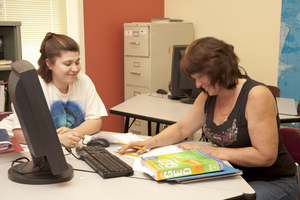 “We give individuals a second chance to take the first step towards a better life,” proclaims Sid Wilson, Executive Director of SBLC/Learning Works.
“We give individuals a second chance to take the first step towards a better life,” proclaims Sid Wilson, Executive Director of SBLC/Learning Works.
About SBLC
SBLC/Learning Works (formerly South Baltimore Learning Center) began 30 years ago as a tutoring program for adults learning to read. Since then, the organization has grown to serve approximately 700 adults each year by providing pathways to educational advancement and workforce readiness.
“What’s unique about SBLC/Learning Works,” explains Wilson, “is our 1:1 tutoring model via the support of our dedicated volunteers. Whether it’s distance learning or a traditional classroom, our learners can progress at their own pace.”
A digital agenda
The Knott Foundation awarded SBLC/Learning Works a grant to upgrade their technology inventory, including new computers, a mobile Chromebook cart, and software licenses.
“The advantages leveraged from new hardware and software were beyond what we anticipated and created a significant shift in the scope and depth of our digital agenda,” says Brandy Carter, Assistant Executive Director of Literary Education.
A pre-grant survey of learners found that nearly 60% did not know how to operate a computer. While SBLC/Learning Works sought to change that figure, the technology upgrades they made showed success on a number of other fronts: increasing access to devices; improving instruction with just-in-time curriculum based assessment measures; and creating new partnerships for fulfilling career pathways for students.
Pathways to the future
SBLC/Learning Works recently cultivated a relationship with Byte Back, a nonprofit career pathways program in the information technology sector. Their learners now have the opportunity to learn essential computer skills, earn industry certifications, and eventually be placed as Help Desk support technicians or other technology-related positions.
“Partnerships like the one we have with Byte Back are so important,” states Wilson. “They are willing to meet our learners where they are and guide them in the direction of their goals.”
For one learner at SBLC/Learning Works – Odith Sandoval – that goal is to improve her English language skills so she can help her two daughters with their schoolwork. Her teachers describe her as a motivated learner and a natural with virtual tools. Her sister also recently enrolled at SBLC/Learning Works and is working towards earning her high school diploma.
Odith has a positive outlook for the future: “Thank you for everything you guys do for us,” she reflects. “I know this is going to help me in my whole life. From here on, everything is going to be different.”
By Kelly Medinger
05-01-2020
Walters Art Museum uses arts & humanities grant to tell a story about one saint’s humility, kindness, and simple living
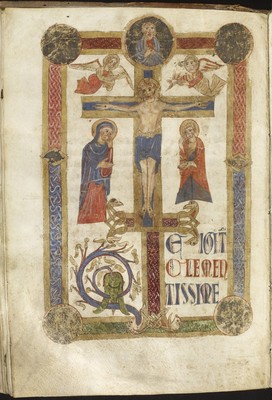 The St. Francis Missal is a 12th-century manuscript and beloved to be a relic of touch of St. Francis of Assisi – founder of the Franciscan Friars and the patron saint of Italy, animals, and merchants. The Missal is housed at the Walters Art Museum in Baltimore and was recently exhibited with the support of the Knott Foundation and other funders.
The St. Francis Missal is a 12th-century manuscript and beloved to be a relic of touch of St. Francis of Assisi – founder of the Franciscan Friars and the patron saint of Italy, animals, and merchants. The Missal is housed at the Walters Art Museum in Baltimore and was recently exhibited with the support of the Knott Foundation and other funders.
The Story of the Missal
In the year 1208, St. Francis of Assisi and two of his followers were debating what God’s plan was for them. Unable to come to agreement, they sought answers at the Church of San Nicolò in Assisi, where Francis often attended. Legend has it that they approached the Missal sitting on the Church’s altar – opened it three times at random – and every time the text on the page implored them to renounce all earthly goods and follow the Lord. This pivotal moment laid the foundation for the Franciscan order.
"The St. Francis Missal is our most frequently requested manuscript,” comments Lynley Anne Herbert, Ph.D., Curator of Rare Books and Manuscripts & Curatorial Chair. “Franciscans from around the world regularly make pilgrimages to the museum to be in its presence.”
The Restoration Project
The restoration of the St. Francis Missal is one of the most extensive conservation treatments on a manuscript completed in the 85-year history of the Walters’ Conservation and Technical Research Lab. Decades of use took a toll on the book’s fragile binding, so there was an urgency to restore it. Overall, the project took two years under the careful direction of Abigail Quandt, Head of Book and Paper Conservation, and Cathie Magee, a Fellow funded by the Andrew W. Mellon Foundation.
The project’s numbers are impressive: 5,000 conservation hours logged; 599 images digitized; 285 manuscript pages preserved; and 30 Walters staff assisting on the project. “We are thrilled to share these scholarly discoveries and to have been able to make this incredible object accessible to all, both onsite and online,” comments Julia Marciari-Alexander, Ph.D., Andrea B. and John H. Laporte Director of the Walters.
About the Exhibition
“Through this exhibit we can tell the story of St. Francis and his followers, St. Clare and St. Anthony, and the impact that they had worldwide," shares Quandt. The exhibition features the legendary Missal along with 17 other objects, including manuscripts, paintings, ivories, ceramics, and documentation of the Missal’s restoration.
Nearly 6,000 visitors came to witness the story of St. Francis and view the Missal during the six weeks the exhibition was open to the public. (The exhibition was shortened due to the COVID-19 pandemic.) After the exhibition, the St. Francis Missal returned to its home in the Walter’s Rare Book Library. It can also be viewed cover-to-cover on the Walters’ manuscript website, Ex Libris.
“This extensive reconstruction really brought the book back to life, now and for future generations,” concludes Herbert.
By Kelly Medinger
04-23-2020
Enoch Pratt Free Library uses human services grant to support its Mobile Job Center, helping Baltimore residents find employment
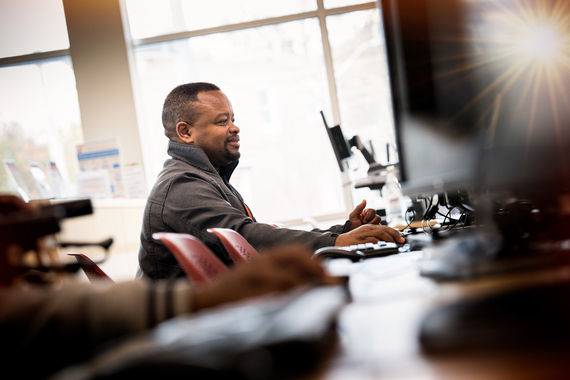 “One great thing about the library is that it’s a place people trust,” comments Meghan McCorkell, Marketing Director of the Enoch Pratt Free Library, “so they feel comfortable coming to us for help.”
“One great thing about the library is that it’s a place people trust,” comments Meghan McCorkell, Marketing Director of the Enoch Pratt Free Library, “so they feel comfortable coming to us for help.”
Mr. McQueen was one of those people. Through the Social Worker in the Library program, he was introduced to the Pratt’s Mobile Job Center for employment counseling. There, he got help writing a resume and applying for jobs. He’s now a Peer to Peer Recovery Coach with one of Baltimore’s major hospitals.
About Enoch Pratt Library
Founded in 1882, the Enoch Pratt Free Library is one of the oldest free public library systems in the United States. It serves Baltimore City residents at its Central location and 21 branches across Baltimore. Their mission is “to empower, enrich, and enhance the quality of life for all through equitable access to information, services, and opportunity.”
The Pratt’s programs extend far beyond books. They offer free legal assistance, career services, and access to social workers, both inside the Library and through outreach programs in the community. “For the longest time the Library has been bordered by its walls, but that has changed,” notes Marlyn Norton, a Librarian with the Mobile Job Center. “We now go to the community that needs us and give them the services they want.”
The Mobile Job Center
The Mobile Job Center opened in 2017 and takes skilled employment specialists on the road to neighborhoods with high unemployment, and where access to an existing Pratt location may be challenging. The Center visits laundromats, barber shops, and even stops when people hail them along the road.
Once inside, people have access to one dozen computers, printers, and the Library’s experienced staff. Approximately ten people cycle through the Center every hour. “We help people no matter what stage they are at in the job search process,” says Ryan O’Grady, Mobile Job Center Director. He and his staff teach small classes and offer one-on-one assistance with resume writing, job searches, interviewing skills, and application submissions.
When the Knott Foundation supported the Mobile Job Center with a grant, the Center reached its goal of serving 15,000 people in the first 6 months of the yearlong award period. In the nine months preceding the closures due to COVID-19, the Center had helped 19,500 customers, answered 11,000 questions, and assisted with 687 resumes and 428 job searches.
A Welcome Surprise
“I love the people who don’t know what the Mobile Job Center is, who walk by, get invited inside, and 30 minutes later walk out with a resume on a flash drive and having applied for a few jobs,” reflects McCorkell. “It’s wonderful to see the smile on their face and their surprise to find out the service is available, and that it’s available for free, in their neighborhood.”
By Kelly Medinger
02-07-2020
St. Clare Parish uses Catholic activities grant to renovate convent for Baltimore area Catholic school teachers to live in a community of faith and friendship
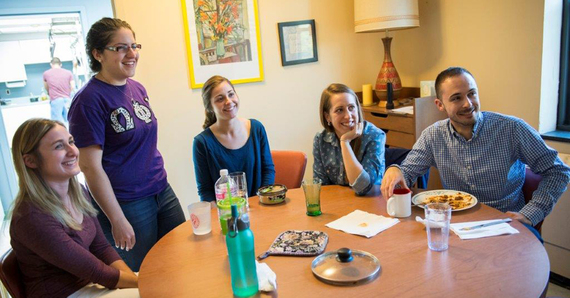 “Our mission is the spread the Word of God and be the Light of Christ for the Essex community in this day in time,” proclaims Father Richard Gray, Pastor of St. Clare Parish in Baltimore County.
“Our mission is the spread the Word of God and be the Light of Christ for the Essex community in this day in time,” proclaims Father Richard Gray, Pastor of St. Clare Parish in Baltimore County.
To further that mission, St. Clare Parish goes beyond offering Mass, sacramental rites, and fellowship programs. Each year, up to ten graduate students who are teaching in Baltimore-area Catholic schools call the Parish’s convent “home.”
“It’s great to have them on our campus,” shares Fr. Gray. “They bring youth and energy to our 11:00 a.m. mass every Sunday, and from a practical perspective, their presence means we don’t have an empty building on our property, and the parish benefits from the added rental income.”
About St. Clare Parish
Opened in 1956, St. Clare Parish serves over one thousand families in the Essex community. The church has been renovated twice – once after a massive fire in 1970, and again in 2016, partly with funds from the Knott Foundation.
In 2018, the church received another Knott grant to upgrade various features of the convent where the graduate education students are housed. The renovation improved the kitchen, added a full bathroom, and addressed some longstanding maintenance issues.
About Operation TEACH
Operation TEACH is a two-year post-graduate service program at Notre Dame of Maryland University, with the goal to develop a corps of highly committed educators to meet the needs of children in Baltimore area Catholic elementary and secondary schools.
Students in Operation TEACH live on a stipend of $14,000/year, teach full-time in a local Catholic school, attend graduate classes on evenings and weekends, and live in community with their fellow teachers. There are currently 16 students in the program who live at St. Clare Parish and St. Thomas Aquinas Church. They teach first grade through high school at 14 different Catholic schools in Baltimore City and Anne Arundel, Baltimore, and Harford Counties.
“Operation TEACH participants have lived in a lot of old convents throughout our 20-year history,” reflects Angela Simmons, Director of Operation TEACH. “St. Clare Parish’s convent is among the best residential facility we have be able to utilize. The facility is in good shape, especially with the recent renovations, and the location is convenient to an abundance of schools across the Archdiocese.”
A Convent Called Home
Monica is from Scranton and teaches middle school language arts at St. Joe’s Fullerton. She describes Operation TEACH as a “bundle deal – with housing, education, a job, and a support system on top.” This is her second year in the program, and when she reflects on the recent convent renovations, she remarks, “My favorite thing is that there’s always someone cooking in the kitchen this year – it’s a great joy to see and makes it feel more like home.”
Fr. Gray concludes with a serendipitous connection to his own life story: “I was a teacher before I was a priest. I taught for eight years in Delaware before going to Seminary. If a program like Operation TEACH had been around back then, I would have been in it.”
By Kelly Medinger
10-02-2019
Mother Seton Academy uses education grant to support their 25th anniversary building campaign
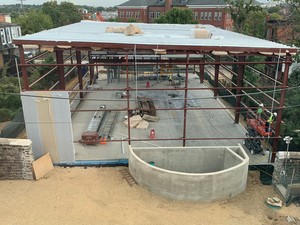 “It’s so great to see the kids watching the new gym being built,” observes Sister Peggy Juskelis, President of Mother Seton Academy. “They see this as a sign of people’s belief in them. To the kids, it’s not just a steel structure, it’s a symbol of the great promise the future holds and the transformative effect of education.”
“It’s so great to see the kids watching the new gym being built,” observes Sister Peggy Juskelis, President of Mother Seton Academy. “They see this as a sign of people’s belief in them. To the kids, it’s not just a steel structure, it’s a symbol of the great promise the future holds and the transformative effect of education.”
About Mother Seton Academy
Located in the Greenmount neighborhood of Baltimore City, Mother Seton Academy was founded in 1993 by a group of six Roman Catholic religious orders. It was named in honor of St. Elizabeth Ann Seton, the first American-born saint and the foundress of the country’s first free Catholic school for girls.
Mother Seton Academy’s 83 boys and girls in grades 6-8 are all on full scholarships. They come to the school through a competitive admissions process, where it is typical to have 80 students applying for only 30 seats. To date, the school has graduated 470 students who have since gone on to become police officers, professional educators, members of the armed services, and more.
“The kids are with us beyond the three years they are here,” comments Sister Peggy. Mother Seton’s graduate support program follows the students through high school, ensuring a near perfect 100% graduation rate every year.
Building a Gym
Before this new gym was under construction, Mother Seton Academy’s students practiced basketball on a makeshift court obstructed by two poles. “They never had a full court to run,” explains Sister Peggy. “Now they will feel like real athletes in a true, high-quality middle school gymnasium.”
The gymnasium will also include a music and community room. “The local community is very pleased with what we’re doing,” shares Sister Peggy. The school plans to offer the community room to the adjacent parish, St. Ann’s Catholic Church, as well as local associations for neighborhood events.
Fundraising for the Project
“The Knott Foundation was the first grantor to support the project,” comments Rachel Trask, Development Director. After the Foundation’s support, Mother Seton Academy’s campaign total grew from $1.3 million to over $3 million. Beyond the capital campaign, Mother Seton Academy also raises approximately $1.5 million each year to fund the school’s day-to-day operations.
Sister Peggy concludes: “The philanthropic community is foundational to the success of Mother Seton Academy and our students. Your faith in our students helps them to believe in themselves.”
By Kelly Medinger
09-27-2019
B&O Railroad Museum uses arts and humanities grant to build a home on their campus for the Baltimore City Mounted Police Unit
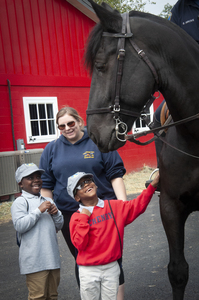 A class of kindergartners from James McHenry School walks out of the B&O Railroad Museum abuzz with excitement. As the first school group to tour the First Mile Stable – an innovative partnership between the Museum and the Baltimore City Police Department – the children had spent the morning meeting horses and talking to Sargent Russ Robar, the head of the City’s Mounted Police Unit.
A class of kindergartners from James McHenry School walks out of the B&O Railroad Museum abuzz with excitement. As the first school group to tour the First Mile Stable – an innovative partnership between the Museum and the Baltimore City Police Department – the children had spent the morning meeting horses and talking to Sargent Russ Robar, the head of the City’s Mounted Police Unit.
About the B&O Railroad Museum
The Baltimore & Ohio Railroad Museum is recognized as the birthplace of American railroading. The Museum holds the oldest and most comprehensive collection of railroad history in the Western Hemisphere.
Located on a 40-acre campus in southwest Baltimore, the Museum is both a cultural anchor for the local community and a destination for more than 185,000 guests each year from around the world. Tours include regularly scheduled train rides, demonstrations of historic equipment, access to the Museum’s fully operational restoration shop, admission to numerous galleries and exhibitions, and a robust educational program for school children that focuses on transportation, history, and innovation.
The First Mile Stable Project
For the past three decades or more, the hard-working horses from Baltimore City’s Mounted Police Unit have lived in a former car dealership beneath a major highway in the City. The B&O recently raised over $2 million to build a stable and paddock for the horses on their 40-acre campus, naming the project “The First Mile Stable.” The term “First Mile” refers to its location where the first mile of long-distance rail was laid and the first passenger station was built.
Visitors to The First Mile Stable will enjoy talking to Sgt. Robar or one of his police officers, as well as meeting the horses themselves. The Unit currently consists of four horses and four officers, but has the capacity to more than double in size in the future. The Unit’s horses are selected for their ability to interact with people and to perform police work. “Big D,” the lead horse for the Unit, has even received an international award for bravery and was just inducted into the Horse Star Hall of Fame.
A Community Builder
“A major purpose of the project is to better integrate the police and the community through educational activities and positive bonding,” states Kris Hoellen, Executive Director. She cites the First Mile Stable’s community classroom and demonstration area as resources for groups to spend time learning about the Mounted Unit and witnessing first-hand how the horses are cared for. School children will be exposed to equine studies, law enforcement, and transportation as potential career pathways.
“The whole project is a way to help reach into the community,” concludes Francis Smyth, Board Chair of the B&O. “Our hope is to help spark community economic development for this area, act as a deterrent for unsafe activity, and ultimately bring more visitors to the B&O as a cultural anchor for the neighborhood.”
By Kelly Medinger
07-03-2019
Mission of Mercy uses health care grant to launch new mobile dental clinic
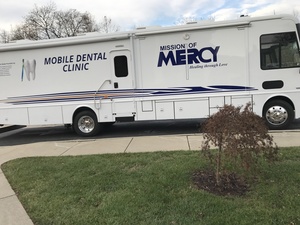 A group of 50 people or so sit in a church hall, waiting for their name to be called so they can see a doctor or a dentist. “Just look at them waiting here, and then look at their faces when they get off the van,” one patient remarks.
A group of 50 people or so sit in a church hall, waiting for their name to be called so they can see a doctor or a dentist. “Just look at them waiting here, and then look at their faces when they get off the van,” one patient remarks.
About Mission of Mercy
Started 25 years ago and operating in Maryland, Pennsylvania, Texas, and Arizona, Mission of Mercy attracts hundreds of medical volunteers who see patients at local sites that host the organization’s traveling medical and dental clinics.
“Mission of Mercy is a medical home for patients who do not have insurance or cannot afford care,” shares Jennifer White, Development Director. For example, 70% of patients at the four clinic sites in Maryland have chronic health issues that require regular care and monitoring, and Mission of Mercy will provide all of their medications, lab work, and doctor’s visits free-of-charge.
Responding to the Need for Dental Care
“We have a real dental crisis in the United States,” explains Linda Ryan, Mission of Mercy’s Executive Director. Dental care is not included in the Affordable Care Act, Medicare, or Medicaid, and supplemental dental insurance is expensive. Combine that with a dearth of general dentistry practitioners, and people are putting off regular dental care until a crisis emerges.
In responding to this need, Mission of Mercy recently launched a new mobile dental clinic, complete with three patient chairs and professional dental equipment, to double the number of patients they serve. The Knott Foundation contributed to the $1 million fundraising campaign, which included purchasing and fully outfitting the mobile dental clinic and funding its first two years of operations.
With the new mobile dental clinic, Mission of Mercy is able to see more patients, as well as store and utilize more high-end instrumentation.
Restoring Smiles
Enter Dr. Roslyn Kellum, DDS, the Dental Director at Mission of Mercy, and a team of volunteer dentists from the communities the clinic serves. Dr. Kellum (who is both a dentist and registered nurse) and the volunteer dentists provide dental care to their patients, but also refer them to the medical clinic for issues such as heart disease, high blood pressure, and diabetes. “You can tell a lot about somebody’s health just by looking in their mouth,” Ryan remarks.
Looking at the faces of patients climbing down the stairs of the new dental van, their smile says it all: “I get pleasure and great joy in restoring patients’ smiles because all smiles matter,” concludes Dr. Kellum.
By Kelly Medinger
06-17-2019
Baltimore Child Abuse Center uses human services grant to grow its grants management team in order to help heal and protect more children
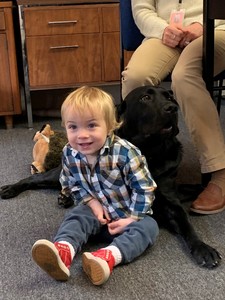 How do you double your grant revenue in a year by applying for fewer grants? Ask the Baltimore Child Abuse Center.
How do you double your grant revenue in a year by applying for fewer grants? Ask the Baltimore Child Abuse Center.
About the Center
Since 1987, Baltimore Child Abuse Center has helped children who have been abused, sexually assaulted, victimized, or witnesses to homicide. The Center, which recently joined LifeBridge Health as a wholly owned not-for-profit subsidiary, provides free services to more than 1,800 children and their non-offending caregivers every year, including medical treatment, forensic interviews, and mental health treatment.
“The violence and trauma a child suffers at the hands of adults takes its toll on their lives and social outcomes,” states LaDonna Morgan, Chief Operating Officer at Baltimore Child Abuse Center. “We are in the fight to protect them and help them on their path to healing.”
Increasing Grants Capacity
The Knott Foundation has supported the Center for more than 20 years. Most recently, the Foundation awarded a grant to increase the Center’s capacity to research, apply for, and administer grants.
One unexpected lesson the Center learned during the grant period: “It’s not as much about the number of grants you win, but the size of those that you do,” states Morgan. The Center actually applied for fewer grants but doubled their grant revenue in just one year, from $1.3M to $3.1M. They did this by seeking larger, multi-year grants, seeing their average award increase from just under $40,000 to $150,000 in 12 months.
“We also developed a new grant strategy, improved our data collection and tracking, implemented program improvements and quality assurance measures, and successfully administered larger and more complex grants than ever before,” comments LeeAnne Woods, Director of Grants Management. “Without the addition of the Grants Coordinator, through the support of the Knott Foundation, we would not have been able to achieve these goals,” continues Woods.
A Path to Healing
More grant funding has allowed the Center to establish a mental health department to better serve children.
“We used to refer children and families to therapists in the community, but we found there was a very low connection rate,” notes Morgan. Grant funding helped the Center hire two therapists and create a therapy department, and in three years the Center has grown the department to six therapists, meaning they can see children immediately, without having to put them on a wait list.
Clearly, Baltimore Child Abuse Center has been successful at turning revenue into results: “Our grants capacity is directly tied to our programmatic ambitions for the organization,” concludes Morgan. “That revenue ensures our doctors, nurses, therapists, and social workers can do the important work they do and positively impact the lives of the children they see.”
By Kelly Medinger
10-22-2018
St. Bernardine Catholic Church in Baltimore City uses Catholic activities grant to launch capital campaign and renovate Church’s entrance

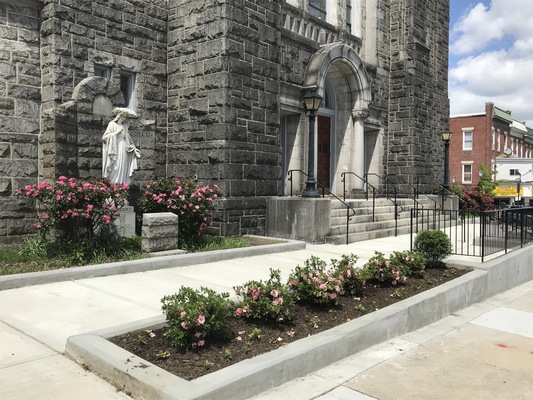 Situated in the Edmondson Village neighborhood of West Baltimore, St. Bernardine Catholic Church has a storied history. As one of the largest Catholic parishes in the City in the 1950s, it nearly closed 20 years later when it struggled to adapt to changing demographics and a changing Catholic Church.
Situated in the Edmondson Village neighborhood of West Baltimore, St. Bernardine Catholic Church has a storied history. As one of the largest Catholic parishes in the City in the 1950s, it nearly closed 20 years later when it struggled to adapt to changing demographics and a changing Catholic Church.
In 1975, Msgr. Edward Miller arrived and chose to see opportunity in the face of the Church’s challenges. He worked with the community to grow St. Bernardine’s into the largest African American parish in the Archdiocese of Baltimore. Today, under the leadership of Msgr. Richard Bozzelli, the parish serves 900 households and is celebrating its 90th anniversary year.
A Pillar of the Community
“Father Miller was a pillar of the community,” reflects Msgr. Bozzelli. “His philosophy was, let’s look at who the neighborhood is and put a Church together for the neighborhood.’ He knew everybody and was highly respected.”
The legacy of Msgr. Miller lives on at St. Bernardine’s. Multiple generations of families remain active in the parish, including the family of one of the first African American parishioners. Even the Church’s leadership is inspired by Msgr. Miller’s approach. The current Pastor was mentored by Msgr. Miller for more than 20 years. He became Pastor of St. Bernardine’s in 2014, a year after Msgr. Miller died, and helped the parish emerge from its grief.
Msgr. Bozzelli’s focus on the community has been a steadying force: the parish is active in the local community association, 40 West Ministries; they host an ongoing food pantry; they provide Christmas gifts and dinner to 100 families each year; and they host an annual neighborhood walk on Martin Luther King Day in honor of their late pastor.
A New Capital Campaign
Built in 1928, St. Bernardine’s Church continues to have a strong spiritual presence, but a deteriorating structural one. Msgr. Bozzelli recently launched a capital campaign, Destined Under the Dome, to make some much-needed repairs and upgrades. The initial campaign goal was $800,000, and the Church has pledges just shy of $900,000.
A grant from the Knott Foundation, designated to repair the exterior steps leading up to the Church, helped kick-off the campaign. With the Foundation’s funds as well as help from parishioners and the Archdiocese, the entrance to the Church was renovated to include new steps, a landing with a small courtyard, and multiple access points from the Edmondson Avenue and Mt. Holly Street.
“When people can see concrete progress – and in this case, it was literally concrete – they are energized,” shares Fr. Rich. “The funding the Knott Foundation gave us really launched our campaign. I’m not sure we would’ve had the same result without it.”
By Kelly Medinger
10-12-2018
Baltimore Chesapeake Bay Outward Bound School uses education grant to send students from two all-girls Catholic schools in Baltimore City on a character-building expedition
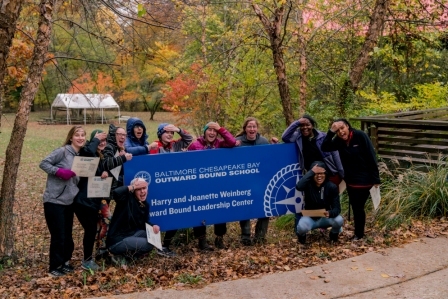 “Ships are safe in harbor, but that’s not what ships are built for,” says Leanna Powell, Fundraising Manager at Baltimore Chesapeake Bay Outward Bound School.
“Ships are safe in harbor, but that’s not what ships are built for,” says Leanna Powell, Fundraising Manager at Baltimore Chesapeake Bay Outward Bound School.
She uses the ship metaphor to describe the organization’s work: “We prepare students to leave the safe harbor of their home, their family, and their community. We give them authentic challenges to confront, on wilderness expedition trips or our Baltimore City ropes course. Then they return home safely – mentally stronger and with the confidence that they can overcome challenges in their own lives.”
About Outward Bound
Outward Bound has been serving the Baltimore community for 32 years. As an educational organization and expedition school, people of all ages and backgrounds participate in active learning expeditions that inspire character development, self-discovery, and service both in and out of the classroom.
“We think of ourselves as a partner to schools,” explains Powell. “Where the traditional classroom might be limited, we can step in with our curriculum and outdoor classrooms to teach kids how to overcome very real challenges, hone their own leadership skills, and develop a greater sense of compassion for others.”
Character & Leadership Initiative for Girls
The Knott Foundation funded the Catholic Girls Character & Leadership Initiative at Outward Bound, which offered programs for two Catholic girls schools in Baltimore City.
The partnership included Sister’s Academy, a tuition-free middle school, and Mercy High School. Nearly 200 students from these schools participated in Insight days, which include a rigorous outdoor challenge course and character education curriculum. Small groups of students from each school also participated in 5-day expedition trips – canoeing on the Potomac and hiking the Appalachian Trail.
Notably, 100% of the girls participating showed gains in emotional self-efficacy, conflict resolution, problem solving, and perseverance. “Ultimately, all teens are at risk, and the window to make an impact on their development is short. What we do helps them make decisions that chart a course for the rest of their lives,” states Ginger Mihalik, Executive Director.
In Their Own Words
The girls who participated in the expedition trips were challenged and changed by their experience. At the end of the trip, their comments ranged from, “Thank you for giving me this opportunity to experience a different environment other than my house,” to, “I got to know myself in ways I may have never seen without this trip. I am now able to trust myself that I am able to do more than what I think.”
Perhaps one participant summed up her transformation the best: “Entering the expedition I was closeminded, not confident, and completely unwilling to try new things. Through this week, I made new friends and hiked more than I ever thought I could, volunteered to be a navigator twice, and ate food of all kinds. I would never exchange this experience for anything.”
By Kelly Medinger
08-23-2018
Charm City Care Connection uses health care grant to help marginalized residents in Baltimore link to high-quality medical care and social services
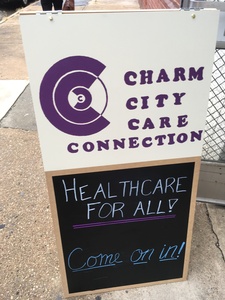 When Macy showed up at Charm City Care Connection’s clinic in East Baltimore, she wanted help getting medical insurance coverage. The case management team signed her up for Medicaid and reconnected her with her primary care doctor. They also recommended she do some preventative health screenings their medical team was offering that day – which was how they found her blood pressure was dangerously high.
When Macy showed up at Charm City Care Connection’s clinic in East Baltimore, she wanted help getting medical insurance coverage. The case management team signed her up for Medicaid and reconnected her with her primary care doctor. They also recommended she do some preventative health screenings their medical team was offering that day – which was how they found her blood pressure was dangerously high.
Without insurance for several months, Macy had been cutting her blood pressure pills in half to save money. Now facing a health crisis, the clinic staff rushed her to East Baltimore Medical Center where a medical team got her blood pressure under control and restarted her on the correct dosage of medication. Crisis averted.
About Charm City Care Connection
Founded in 2009 by Hopkins students in collaboration with the East Baltimore community, Charm City Care Connection (CCCC) helps Baltimore’s poorest families access high-quality medical care and social services. CCCC staff and volunteers meet with clients through walk-in clinic hours at two community locations and build long-term relationships with them through home visits, phone calls, text messages, and hospital visits.
“Macy’s case is a wonderful example of how we connect residents to the health care they need and want, and also find undetected health issues that could easily get out of hand,” says Wynn Engle-Pratt, Executive Director of CCCC. Macy is now working with CCCC’s medical student volunteers on long-term goals to continue to improve her health and wellbeing.
Expanding to Meet the Needs
CCCC received a Knott Foundation grant in 2017 to expand its services and open a second clinic location. Using neighborhood indicators, the organization selected Dee’s Place as their second site. Dee’s Place is one of the only 24-hour-a-day addiction programs in Baltimore, and research shows addiction issues have a strong correlation with chronic health and social service needs.
With two locations in East Baltimore that residents know and trust – Dee’s Place, and one at The Men and Families Center – CCCC has seen its client base grow by more than 40% and has been able to make even more referrals to social services. Most often, clients need help getting dental care, finding affordable stable housing, and enrolling in medical insurance. Access to mental health treatment is a rising need as well.
“Overall our success rate is about 75% for meeting a client’s individual need for services,” notes Engle-Pratt. The most common barriers are dental care (which is often not covered by insurance) and access to mental health treatment.
New Ways to Promote Health and Well-Being
CCCC hasn’t stopped growing. The organization just piloted a community training program for Naloxone use in emergency situations and is now looking to develop a healthy cooking and lifestyle class. They are also preparing to welcome a group of new nursing student volunteers from Johns Hopkins School of Nursing to complement the teams of medical residents and students already dedicating their time to CCCC.
“My future interest lies in how to incorporate Charm City Care Connection’s comprehensive model for meeting patients’ needs into the wider healthcare system,” reflects Engle-Pratt. “There is a real opportunity for primary care to provide day-to-day, long-term case management and address people’s needs for housing and other services that so greatly impact their health.”
By Kelly Medinger
05-03-2018
Baltimore Center Stage uses arts and humanities grant to provide access for all
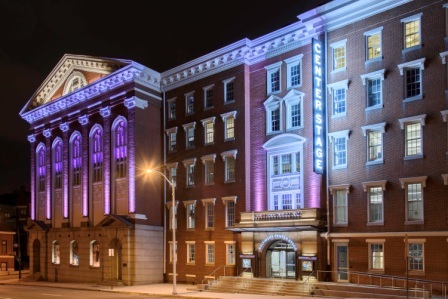 When he’s not running the Front of House at Baltimore Center Stage, you might find Alec Lawson, Audience Services Manager, narrating one of the theater’s productions for a visually impaired audience member.
When he’s not running the Front of House at Baltimore Center Stage, you might find Alec Lawson, Audience Services Manager, narrating one of the theater’s productions for a visually impaired audience member.
The audience member wears an earbud, with Alec (or another trained member of his staff) providing a detailed, live audio description of the set, costumes, entrances and exits of each actor, and action on stage. “Doing a good audio description is tricky,” says Lawson. “You have to watch the show many, many times to learn how to break it down, and you have to share information strategically since you can’t talk while an actor is talking.”
About Baltimore Center Stage
Founded in 1963, Baltimore Center Stage is the City’s leading professional producing theatre, named the State Theatre of Maryland in 1978. It welcomes nearly 100,000 people each season from all 24 Maryland counties.
In 2017, the theatre completed a $33 million renovation, which included upgrades to the technology and services available to patrons with special access needs. The Knott Foundation supported Baltimore Center Stage with this work, awarding a grant for new assistive listening devices, improved captioning services, American Sign Language interpreted performances, increased audio description offerings, and more availability of Braille and large print programs.
An Enhanced Theatre Experience
Audiences are putting the new services and equipment to good use.
Approximately 750 people each season benefit from assistive listening devices and captioning services, and another 15 members subscribe to the American Sign Language interpreted performance of the mainstage productions. Braille and large print programs continue to be printed at 20 per show.
An average of 100 people also attend “touch tours” of the theatre each season, where they learn about a particular performance by touching props, costumes, and stage items. While staff originally designed the tours for the visually impaired, a large number of attendees have been children. “By opening the touch tours to everyone and attracting lots of kids, it has created a really nice sense of community where we can all interact together to experience theatre,” comments Lawson.
A Commitment to Diversity and Access
“Diversity and access are key priorities for Baltimore Center Stage,” notes Brandon Hansen, Institutional Giving Coordinator. He points to the evidence: One quarter of their audience identifies as a race other than white, and over a third of households have an annual income below $75,000. The newly renovated Head Theater is equipped with removable seats accessed immediately from the entrance ramp, with wheelchair accessible seats built into the theater’s design. Anyone can email access@centerstage.org with a question and one of eight staff members trained in accessibility issues will respond.
Baltimore Center Stage’s accessibility program has achieved national recognition, so much so that Lawson and a colleague have been invited to present at the Leadership Exchange for Arts and Disabilities. Their presentation will address how to create inclusive programs that reflect diverse communities, how diversifying opens perspectives and opportunities, and the role volunteers play in a successful accessibility program.
“Access for all applies to everyone,” emphasizes Lawson. “We often talk about access in the context of race or socioeconomic status, but access needs exist across a wide spectrum.” That could include people who have low vision, are hard of hearing, or have a family member with autism. “These groups with special access needs have often been taught to hide,” Lawson continues. “Here at Center Stage, we want to make theater a welcome place for everyone, to come as you are.”
By Kelly Medinger
05-03-2018
Partners In Care uses human services grant to harness the talents of its members to support the independence of older adults
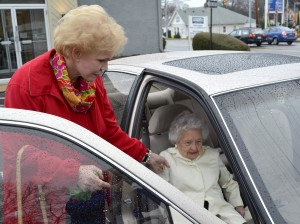 “It’s my heart and soul, and the most phenomenal place I’ve ever worked,” declares Mandy Arnold, President & CEO of Partners In Care in Anne Arundel County. Reflecting on her 23-year career in healthcare, she is thankful to be in a place where community members come together to help one another, with a special focus on the senior population.
“It’s my heart and soul, and the most phenomenal place I’ve ever worked,” declares Mandy Arnold, President & CEO of Partners In Care in Anne Arundel County. Reflecting on her 23-year career in healthcare, she is thankful to be in a place where community members come together to help one another, with a special focus on the senior population.
About Partners In Care
For 25 years, Partners in Care (PIC) has helped older adults remain independent and an active part of their community, through the exchange of the time and talents of its membership. Its membership has grown dramatically since its founding, from 13 volunteers helping roughly a dozen seniors, to more than 900 volunteers helping upwards of 1,000 older adults.
PIC’s services mostly consist of transportation and home repairs, both of which support seniors aging in place. Members do not pay money for these services, but rather give their time and talent in exchange for them. The membership process includes an application, orientation, and background check. Whether a member is a provider or receiver of services, everyone is considered a member, and no one is turned away.
The Knott Foundation has awarded PIC five grants over the past 15 years, most recently for general operating support. “We could not do what we do without this type of support,” shares Mandy.
Stories From the Field
One PIC member drove a patient to her chemotherapy appointments for an entire first round of treatment. When the patient needed a second round of treatment, the member rearranged her schedule so that she could be the one to continue driving her. The patient’s cancer is now in remission.
Another member had been driving a 94-year-old woman to the grocery store for some time, when a new PIC volunteer took the shift. The member called to check-up on the new volunteer and make sure he was “doing everything right,” Mandy laughs. “She wanted to make sure the new volunteer was going into the store with the woman, getting everything on her list, stopping to buy her and her husband a sub on the way home, and putting all the groceries away in the cupboard once they were home.”
A Talent Bank
When asked how PIC has managed to grow over the years and still maintain such a personal touch, Mandy states, “Everyone is treated with dignity and respect. Their value is based on the time they can commit, not monetary net worth. Members feel it is a give and take, and not a charity.”
Leveraging the time and talent of members is a serious part of PIC’s service model. Some members provide home repairs. Other members write birthday cards to the general membership. Recently, 25 members baked deserts for a local fundraising event.
“Everyone has their own talent and all of these talents together is what we were created to be – an organization of neighbors helping neighbors,” Mandy concludes.
By Kelly Medinger
02-07-2018
Port Discovery Children’s Museum uses arts and humanities grant to make science fun for students at four Catholic schools in Baltimore City
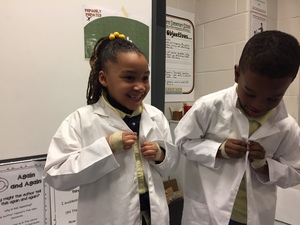 “Science is the way we learn about everything in the world,” wrote one student. She was responding to the question, “How do you feel about science?” after partaking in the Port Discovery Children’s Museum STEMventures program. “Port Discovery’s research-based, proven philosophy is that playful, joyful learning broadens children’s horizons, builds their self-esteem, sparks their creativity, and piques their lifelong interest in subjects like science,” explains Bryn Parchman, President and CEO.
“Science is the way we learn about everything in the world,” wrote one student. She was responding to the question, “How do you feel about science?” after partaking in the Port Discovery Children’s Museum STEMventures program. “Port Discovery’s research-based, proven philosophy is that playful, joyful learning broadens children’s horizons, builds their self-esteem, sparks their creativity, and piques their lifelong interest in subjects like science,” explains Bryn Parchman, President and CEO.
Mission and Outreach
The mission of Port Discovery Children's Museum is to connect purposeful play and learning, with the goal to develop smarter, healthier, engaged kids. Port Discovery is counted among the country's top children's museums and has served nearly five million visitors, or about 270,000 people annually.
In 2016, Port Discovery teamed up with the four Catholic community schools in Baltimore City. Archbishop Borders, Cardinal Shehan, St. James and John, and Holy Angels Schools serve children in grades pre-K-8 from at-risk neighborhoods. “Our relationship with these schools is really an extension of our efforts to reach kids in as many low-income, urban schools as possible,” shares Christina McLoughlin, Grants Director.
Meeting Content Objectives
The Knott Foundation awarded Port Discovery a grant to offer its STEMventures after-school program to students at the Catholic community schools, as well as on-site workshops and field trips.
After participating in five-week program series on themes including primates, nanoscience, and engineering, students from the Catholic community schools showed respectable gains in knowledge. For example, the percentage of students who knew primates are a group characterized by a large brain, 3D vision, and opposable thumbs grew from 46% to 90%. And 88% of students identified the correct image of a DNA molecule, a 60% increase from before the program.
Equally as important, the students had fun. In Nanoscience Exposed, students learned about things too small to see and enjoyed a theatrical performance by New Moon Theater called “Alice in Nanoland.” The Everyday Engineers session taught about the five main branches of engineering – civil, electrical, mechanical, chemical, and aerospace – and allowed students to perform experiments, build structures, and create the ultimate slime.
Building Relationships
Beyond this content area knowledge, Port Discovery strives to create a comfortable atmosphere where children feel they can explore science. That feeling of comfort starts with the people in the room when the program is happening. With the same facilitators from the Museum running all of the programs at each school, students looked forward to their arrival and developed strong bonds with them.
These relationships – coupled with the exciting content of each program series – ultimately helped create more positive attitudes about science. At the conclusion of the program, one student described it best when she exclaimed, “Science is my life!”
10-16-2017
A short video celebrating the work of Caroline Center and our relationship with them
In celebration of our 40th anniversary year, the Knott Foundation is releasing three short video stories about our grantees.
This video features Caroline Center, an education and health care career skills training program for women in Baltimore City dedicated to helping each woman see and achieve their potential in their personal and professional life.
By Kelly Medinger
10-11-2017
Druid Heights Community Development Corporation uses education grant to support programs for youth in west Baltimore
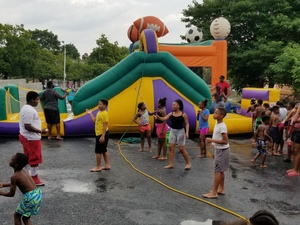 A list of rules sits on every table in Druid Heights Community Development Corporation, where a group of approximately 20 young people are gathered afterschool. “Be respectful to everyone,” and “don’t destroy things” are two points on the list. “The kids came up with these rules themselves,” explains Anthony Pressley, Executive Director, “so they’re worded the way they would talk.”
A list of rules sits on every table in Druid Heights Community Development Corporation, where a group of approximately 20 young people are gathered afterschool. “Be respectful to everyone,” and “don’t destroy things” are two points on the list. “The kids came up with these rules themselves,” explains Anthony Pressley, Executive Director, “so they’re worded the way they would talk.”
About Druid Heights CDC
Established in 1974, Druid Heights Community Development Corporation (Druid Heights CDC) seeks to cause, encourage, and promote community self-empowerment in west Baltimore through economic, educational, employment, and affordable housing opportunities.
“We’ve built more than 100 homes as a community developer,” states Pressley. “And this year we helped 28 families transition from renting to owning their own home. Our key to making this community more successful is home ownership,” he adds.
Enriching the lives of young people
In addition to helping house a wide spectrum of people – from seniors to young families – Druid Heights CDC hosts a variety of youth programs, which the Knott Foundation has supported.
A popular program is the summer camp, which is the only free camp in the neighborhood. The mandatory parent orientation for the camp showcases a video about the disparity between a child growing up in the county and one in the city. “The film helps parents buy in to the program – because if what we’re doing at camp isn’t supported at home, then ultimately we won’t get the kids where we want them to be,” reflects Pressley.
This past summer Druid Heights CDC hosted 86 youth and 40 YouthWorks students in its summer camp, with evaluations showing positive results in preventing summer learning loss, the camp’s primary goal.
“In the afterschool program, we have to be more creative,” says Pressley, explaining that parents often take a more relaxed approach to afterschool and allow their kids to do what they want. “We make it fun so the kids want to come back,” he says, “and provide supper so the parents don’t have to worry about it.”
Creating community partnerships
A large part of Druid Heights CDC’s successful programming for youth comes from community partnerships: the Maryland Food Bank (free supper), the Peabody Conservatory (twice weekly harp classes for youth), the Baltimore Policy Department (mentoring), and St. Peter Claver Catholic Church (gym space), to name a few.
Often these partnerships bear witness to the organization’s commitment to building community and breaking down racial barriers. For example, during the grant period, Druid Heights enhanced its cultural enrichment program for youth by forging a relationship with Beth Am Synagogue, bringing together ten African American teens and ten Jewish American teens for two weekends per month for discussions, lunch, and travel.
“We couldn’t do all this without the support of the community,” Pressley concludes. “Our programming and our partnerships really show our direct impact on families and children in our neighborhood.”
By Kelly Medinger
10-02-2017
Gilchrist Center Baltimore – Joseph Richey Hospice uses health care grant to provide compassionate, personalized care in Baltimore City
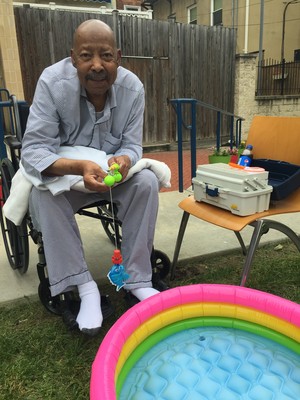 When Melvin came to Joseph Richey Hospice, he likely did not expect a party thrown in his honor. It turns out Melvin loved to fish, and he often spoke to the hospice staff about taking a fishing trip before he reached the end. When a trip with a friend fell through, the staff decided to take matters into their own hands: they threw a fishing party for Melvin in the backyard of the house, complete with a kiddie pool, fishing poles, and party hats.
When Melvin came to Joseph Richey Hospice, he likely did not expect a party thrown in his honor. It turns out Melvin loved to fish, and he often spoke to the hospice staff about taking a fishing trip before he reached the end. When a trip with a friend fell through, the staff decided to take matters into their own hands: they threw a fishing party for Melvin in the backyard of the house, complete with a kiddie pool, fishing poles, and party hats.
For people like Melvin, Joseph Richey Hospice is often the only place to find quality, end-of-life care. “There are no other residential options in Baltimore City for people who don’t have the resources or a strong support system,” remarks Ted Blankenship, Director of Development.
About Joseph Richey House
Joseph Richey House is a 19-bed hospice in Baltimore. No one is turned away due to an inability to pay. Like Melvin, patients often do not have a caregiver at home, or even a stable living environment. Some have experienced homelessness, incarceration, or addiction, and many have been underserved medically.
Patients are referred to Joseph Richey by a physician because they suffer from a terminal illness and have less than six months to live. What they find when they get there, however, is a deeply compassionate medical team and support system, including a social worker, bereavement counselor, chaplain, and more than 20 physicians who volunteer their time to treat patients at the House.
A Baltimore blessing
Joseph Richey was founded in 1987 by The All Saints Sisters of the Poor and Mt. Calvary Church. Since that time, approximately 8,000 patients and their families have been served. The Knott Foundation has supported the organization for ten years.
In 2014, Joseph Richey was acquired by Gilchrist Center Baltimore to bolster its financial standing and prospects for future success. “Both Joseph Richey and Gilchrist saw a need that existed for end-of-life care in Baltimore, that otherwise wasn’t being filled. Joining forces ensured that commitment to serving the City and the underserved,” comments Blankenship.
Gilchrist’s relationship with Joseph Richey has helped the hospice serve more medically complex patients, as well as cover the uncompensated care cost that the small nonprofit faces each year due in large part to the fact that Medicaid does not cover patients’ food and lodging. “We really depend on grants and donations from individuals to be able to deliver the care we are providing,” shares Blankenship.
Looking to the future
“With a strong organizational structure in place, recent capital renovations, and a burgeoning fundraising campaign, we are all very pleased with the growth that’s been happening at Joseph Richey House,” says Blankenship.
“We may be a small nonprofit, often flying below the radar screen,” he notes, “but we always find a way to serve those who need it most… and do so in a way that brings compassion, dignity, and a personal touch to their final life celebration.”
08-17-2017
A short video celebrating the work of St. Francis Neighborhood Center and our relationship with them
In celebration of our 40th anniversary year, the Knott Foundation is releasing three short video stories about our grantees.
This video features St. Francis Neighborhood Center, a community-based organization located in Reservoir Hill dedicated to ending generational poverty and strenthening connections in the Baltimore community.
05-24-2017
A short video celebrating the work of St. Elizabeth School and our relationship with them
In celebration of our 40th anniversary year, the Knott Foundation is releasing three short video stories about our grantees.
This video features St. Elizabeth School, a Catholic school for students with special needs.
By Kelly Medinger
05-05-2017
Fellowship of Catholic University Students (FOCUS) uses Catholic activities grant to help Towson University students find fulfillment through faith and friendship
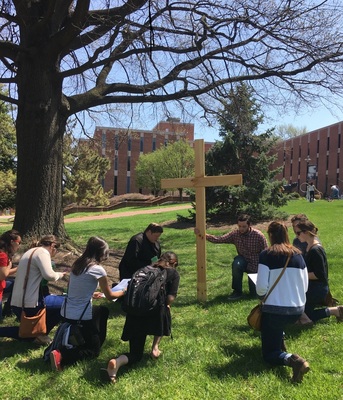 Four out of five people who leave the Catholic Church do so between the ages of 18 and 23. Meanwhile, the American College Health Association routinely reports widespread unhappiness among college students in this age range. So how does the Church find those who are lost and ultimately show them a path to a more fulfilling life?
Four out of five people who leave the Catholic Church do so between the ages of 18 and 23. Meanwhile, the American College Health Association routinely reports widespread unhappiness among college students in this age range. So how does the Church find those who are lost and ultimately show them a path to a more fulfilling life?
Connecting College to Christ
Fellowship of Catholic University Students (FOCUS) is the largest and fastest growing apostolate dedicated to the evangelization of college students. Its purpose is to engage a generation of young adults – those most at risk for disconnecting from their faith – as active participants in the Church through small group bible studies, large group leadership training, one-on-one discipleship, and social gatherings.
Founded in 1998, FOCUS missionaries now serve more than 100 college campuses across the United States, including four in Maryland: Mount St. Mary’s University in Emmitsburg, the University of Maryland in College Park, the US Naval Academy in Annapolis, and most recently, Towson University.
In just two short years at Towson University (and a grant from the Knott Foundation), FOCUS has helped the Catholic community expand from a handful of students involved in planning their own activities, to a group of more than 70 students, missionaries, and student leaders engaged in community outreach, interfaith dialogue, religious practice, and social events. In the words of a vice president in administration at the college: “It’s great that Catholic campus ministry has awoken again.”
A Home Away from Home
“When you go to college, you want to belong somewhere,” says Nan Leahy, Philanthropy Officer. “FOCUS provides that environment for these students and becomes their support system outside of their family.”
Amber Cybulski graduated from college interested in the field of college ministry but unaware of FOCUS. She learned about the organization from a friend, applied to become a missionary, and then took part in an intensive 5-week training program for new staff. Today Amber meets with Towson students one-on-one and helps to lead the Newman Center’s campus ministry activities. Through this discipleship, she has witnessed positive developments in students’ friendships, compassion, willingness to lead, and ability to make good choices.
“So much comes down to good choices,” adds Father Matt Buening, Director of Catholic Campus Ministry at Towson University. “Having the guidance of faith, a community to support them, and good friendships to help them make good choices is so important during college.”
A Time for Conversion
“In a way college is actually the easiest time for conversion,” shares Cybulski, “because you are not yet tied to a spouse, children, job, profession, or way of life, and perhaps for the first time you are charged with making decisions without the influence of your parents.”
Indeed, the culture of FOCUS has proven to be a powerful catalyst for conversion and discernment. Fr. Matt was recently contacted by an unbaptized student interested in exploring the Catholic faith. Simultaneously, FOCUS has inspired two recent Towson graduates to enter the seminary.
“When you fall in love with Christ, it just transforms everything,” says Fr. Matt. “This growth in the human person then translates into effective servant leadership, renewed dedication to the important things in life, a true commitment to helping the community, and a more fulfilling journey through life.”
By Kelly Medinger
05-04-2017
CASA of Allegany County uses human services grant to be a voice for more foster children
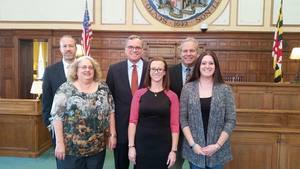 “While the number of children in foster care is declining in Maryland, the number in Allegany County has nearly doubled over the last four years, largely due to the drug epidemic,” says Misty Raines, Executive Director of CASA of Allegany County. Citing one of many examples, Raines shares the story of a young mother in Cumberland who recently died from an overdose, leaving her two young children with no options other than foster care.
“While the number of children in foster care is declining in Maryland, the number in Allegany County has nearly doubled over the last four years, largely due to the drug epidemic,” says Misty Raines, Executive Director of CASA of Allegany County. Citing one of many examples, Raines shares the story of a young mother in Cumberland who recently died from an overdose, leaving her two young children with no options other than foster care.
About CASA
Located in rural western Maryland, Court Appointed Special Advocates (CASA) of Allegany County was founded in 2012 by two local citizens who had seen the results and benefits of CASA programs in nearby towns in West Virginia. The organization hired Raines as Executive Director in 2013, and in 2014 their first CASA was appointed by the court.
CASA of Allegany County has trained approximately 40 CASAs since its founding. These volunteers are currently advocating for approximately 25 foster children, speaking to everyone on the child’s behalf in order to create the best life situation for them – whether that is adoption, kinship care, or other living arrangements.
“People in Allegany County are really starting to recognize our program and see the benefits,” comments Raines. “We actually had to waitlist a number of volunteers at our most recent training, because interest was so high.”
Being There for Kids
The Knott Foundation has awarded CASA of Allegany County two grants since it opened its doors. “When I think of where we were in the very beginning with our first grant – wondering what the next year would look like for all these kids in the foster care system – to where we are today with so many active CASAs, it is a testament to all the great people who have worked so hard to make a difference in our community,” shares Raines.
CASA is a serious volunteer commitment in the life of a child, and volunteers are trained accordingly. CASAs go through a rigorous 5-week training program based on a national curriculum. All are asked to commit to 12 months of service, or the life of the case to which they are assigned. For some volunteers, this can mean several years of service.
Such is the case for CASA Don, who has served his child for three years. Once or twice a month, CASA Don drives more than three hours to visit the child in a special group home setting. They go out for lunch, shop for things the child might need, see a movie, or celebrate birthdays together. CASA Don is his only visitor; the boy’s mother died of cancer, his father was his abuser, and he has no siblings.
CASA Roni Ringler sums it up like this: “Albert Einstein said, ‘Only a life lived for others is worth living.’ Through my decades of adulthood, I have tried to live by this – as a teacher, crisis counselor, friend, and now, a CASA. Becoming a CASA has made me a better person, a more determined person, with the hope my child will be reunited with parents, foster parents, or adoption that will regain a stable and happy home life for them. It is my honor to be a CASA and I am thankful for this.”
By Kelly Medinger
02-13-2017
St. Vincent de Paul of Baltimore uses human services grant to upgrade information technology across 13 program sites serving the poor
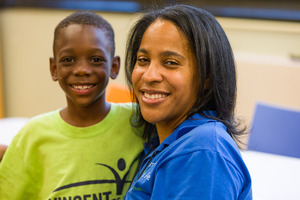 As one of the region’s larger human service organizations, St. Vincent de Paul of Baltimore provides a path from poverty to self-sufficiency for many residents of Baltimore. A continuous focus on program quality recently led the organization to investigate ways to use information technology to enhance the services delivered to those in need.
As one of the region’s larger human service organizations, St. Vincent de Paul of Baltimore provides a path from poverty to self-sufficiency for many residents of Baltimore. A continuous focus on program quality recently led the organization to investigate ways to use information technology to enhance the services delivered to those in need.
About St. Vincent de Paul
St. Vincent de Paul of Baltimore’s mission is to ensure those impacted by poverty have the skills and resources to achieve their full potential. More than 150 years after its founding at the Basilica of the Assumption in Baltimore, St. Vincent de Paul’s programs remain inspired by its Catholic roots. Today, in the tradition of its founder, Frederic Ozanam, the organization continues to help people move beyond hunger, homelessness, unemployment, and childhood poverty.
With 13 programs – including a homeless resource center, Head Start, housing services, family homeless shelters, and employment training – St. Vincent de Paul reaches thousands of men, women, children, and families each year, moving them beyond poverty to achieve a better future. These numbers represent significant growth over the past decade: In that time, St. Vincent de Paul has doubled its number of employees and added multiple new site locations and programs.
Such exponential growth creates challenges and opportunities. “We recognized that in order to be a better, higher functioning, more informed organization, we needed to put some time and resources into information technology,” states Matthew Kurlanski, Director of Foundation Relations & Grants and a member of the Information Technology Architecture Steering Committee.
Technology as a Tool
The Knott Foundation awarded St. Vincent de Paul a grant in 2015 for the first phase of its technology upgrade. “Very few funders will support the back-office infrastructure that enables the front-line case managers and program staff to do their jobs better,” remarks Kurlanski. “If we hadn’t received the Knott grant as a first investment, we wouldn’t have gotten the momentum we needed to get the project off the ground.”
Grant funds were spent on upgrades to the network infrastructure at 13 program sites, on a virtual Chief Information Officer, and on a network backup solution. The changes, however small, have begun to increase cross collaboration between programs and have made St. Vincent de Paul’s operations more streamlined and cost effective. For example, during a Baltimore City audit last year, documentation about programs was collected electronically utilizing the Office 365 cloud functions from multiple sites. This lessened the burden on front-line staff to sort and organize large volumes of paper and helped auditors to quickly and thoroughly review the organization’s program performance.
Future efforts include transitioning from using four different data management systems to track progress across all programs, to a single tracking and evaluation system. “Our goal is to use information technology to lay the foundation for becoming a more collaborative, more unified, more outcomes-focused organization,” concludes Kurlanski.
By Kelly Medinger
09-12-2016
University of Maryland St. Joseph Medical Center uses health care grant to renovate and expand Mother Baby Unit
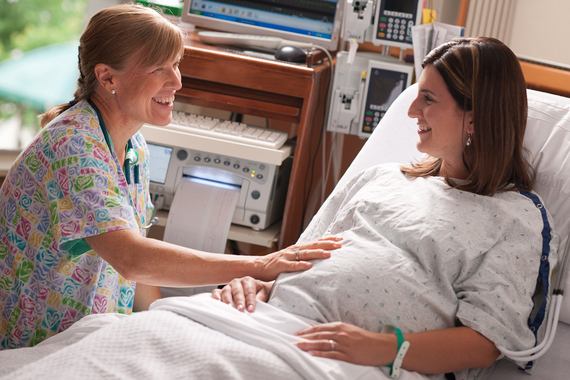 Special deliveries arrive each day at University of Maryland St. Joseph Medical Center: more than 2,200 babies are born at the Catholic hospital in Towson every year.
Special deliveries arrive each day at University of Maryland St. Joseph Medical Center: more than 2,200 babies are born at the Catholic hospital in Towson every year.
St. Joe’s recently completed a campaign to renovate and expand its Mother Baby Unit, where the arrival of new life is celebrated in fine fashion. “Each birth is a sacred event,” describes Judy Rossiter, MD, Chief of Obstetrics and Gynecology and Director of the Perinatal Center. “The mother is an integral part of the team and decisions are made with her input. We do what is best for the baby and the mother, in body and spirit.”
About the Hospital
For more than 150 years, University of Maryland St. Joseph Medical Center has provided loving service and compassionate care to the greater Baltimore community. Notably, the 238-bed hospital in Towson is the only Catholic hospital in Baltimore County providing obstetric services.
“That is what sets us apart – our commitment to our faith-based mission,” states Jill Huey, Executive Director of the UM St. Joseph Medical Center Foundation. Daily prayers are said over the intercom. Brahms Lullaby plays every time a baby is born. A memorial service is held for all babies who are lost each year. “Our faith sets the tone for everything that happens in this institution,” Huey recounts.
In 2012, the hospital became part of the University of Maryland Medical System (UMMS). Because UMMS is a privatized system, St. Joe’s was able to remain a Catholic hospital operating under the ethical and religious directives of the Church. “After nearly four years in UMMS, we have returned to profitability, have received numerous awards for excellence and, most importantly, our patients have come back, drawn by the loving care they experience,” comments Senator Francis X. Kelly, Jr., Chairman of the medical center’s Operating Board.
Raising Standards… and Money
That loving care is especially evident in the Mother Baby Unit. Yet the physical space has not always matched the superior level of service that families receive. Until recently, parts of the unit had remained untouched since the hospital was built in 1965.
In 2015, St. Joe’s embarked on a capital campaign, Building For Our Future, to address the facility’s needs. The total cost to renovate the Mother Baby Unit was $2 million, and all $2 million was raised from public and private support – in just one year. The Knott Foundation awarded the largest foundation grant to the campaign, funding the design schematics for the renovated space.
When finished in 2017, there will be a new welcome area with better signage, improved triage space, renovated postpartum rooms, and a bereavement room for families who experience a loss. With these enhancements, the hospital will be able to provide enhanced care for families, including a faster and more private experience for expectant mothers when they arrive at St. Joe’s to give birth.
In the meantime, more special deliveries arrive each and every day as St. Joe’s joins new moms and dads in celebrating the birth of their children.
By Kelly Medinger
08-30-2016
Dyslexia Tutoring Program uses education grant to help low-income children learn to read
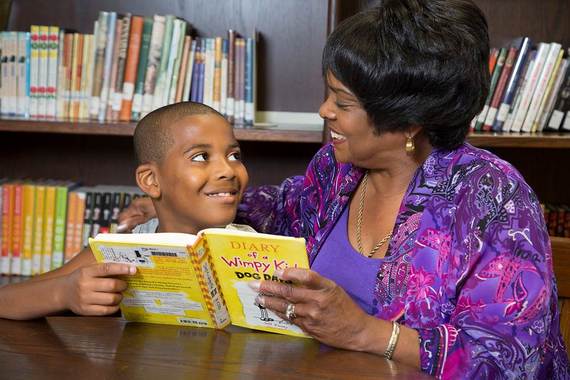 “One of the things we always say is, ‘If you can’t read, you can’t do anything,’” states Marcy K. Kolodny, CEO of the Dyslexia Tutoring Program. “Many times children come to us in the third grade and have already started to lose their self-esteem simply because they can’t read.”
“One of the things we always say is, ‘If you can’t read, you can’t do anything,’” states Marcy K. Kolodny, CEO of the Dyslexia Tutoring Program. “Many times children come to us in the third grade and have already started to lose their self-esteem simply because they can’t read.”
An estimated 15-20% of the population is dyslexic or has a language-based learning disability (International Dyslexia Association). Couple that statistic with the fact that only half of all third graders in Baltimore can read at grade level, and the need to intervene becomes clear.
About DTP
Dyslexia Tutoring Program (DTP) was founded in 1982 by a group of concerned citizens who sought to demonstrate that with a small investment of time and energy, the chain of dyslexia could be broken.
DTP works with approximately 200 children and adults in Baltimore and surrounding counties who are dyslexic or have a language-based learning disability and can’t afford private tutoring. DTP’s volunteer tutors are trained in the 22-hour Orton-Gillingham method of teaching reading, writing, and spelling. They come from a variety of backgrounds including lawyers, teachers, stay-at-home moms, retired men and women, and business people. And they all want to give something back to their communities.
“As far as we know, we’re one of the only organizations in the country to provide these services free of charge,” Kolodny says. Private tutoring can cost between $70 and $100 an hour, far out of reach for students and their families.
Providing Opportunity and Hope
“A lot of our students are very bright. It’s just that they can’t read,” Bob Morton, Program Director, says. To learn to read, a student meets with his or her DTP tutor for one hour at least once a week. DTP then re-screens the student after every 30 hours of tutoring to measure improvement in areas such as word identification, word attack, spelling, fluency, and comprehension.
While assessments and scores can show a student’s improvement throughout the school year, the greater impact comes later and is perhaps more difficult to measure: “By increasing a student’s reading ability, research says you increase his or her self-esteem, develop character, and create skills needed for future success in high school, college, vocational school, the workplace, and other life endeavors,” says Kolodny.
Ten of DTP’s students are now in college, and three just graduated. Of the five DTP students who finished high school this year, all of them plan to attend college.
One of the program’s students, Tavon, called one day to ask if Kolodny could help him get a part-time job. The Marriott Waterfront Hotel offered him a job as a busboy. He then became a waiter and was accepted into their management training program, where he soon became a Captain, and last summer was promoted to Assistant Manager of the Catering and Events Department. “If it were not for DTP,” he says, “this would never have happened.”
By Kelly Medinger
04-13-2016
Art with a Heart uses arts and humanities grant to prepare formerly homeless youth for the workplace
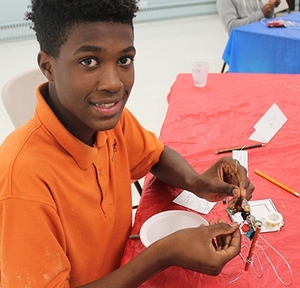 Fifteen new employees – all formerly homeless youth – are seated in an art studio for their new job orientation. “This is not just about making art. It’s about job readiness,” says the orientation director. She explains that they will be learning many different artistic techniques throughout their employment, but if they are late for work by only ten minutes, they will not get paid that day. “Punctuality is important on the job, and docking your pay may seem harsh, but at least you keep your job.”
Fifteen new employees – all formerly homeless youth – are seated in an art studio for their new job orientation. “This is not just about making art. It’s about job readiness,” says the orientation director. She explains that they will be learning many different artistic techniques throughout their employment, but if they are late for work by only ten minutes, they will not get paid that day. “Punctuality is important on the job, and docking your pay may seem harsh, but at least you keep your job.”
About Art with a Heart
Founded in 2000, Art with a Heart provides classes in visual arts to underserved Baltimore area children, youth, and adults. Their mission is to enhance the lives of people in need through visual art.
Part of Art with a Heart’s programming includes the Youth Entrepreneurship Program, which employs cohorts of youth in the spring, summer, and fall to create marketable art to sell in Art with a Heart’s retail store, HeARTwares. Youth complete a variety of art projects, such as designing table and chair sets in teams and learning other artmaking skills like wire and beading, wood burning, ceramics, and mosaics.
Teaching Soft Job Skills
In 2015, the Knott Foundation supported the Youth Entrepreneurship Program’s expansion from summer to year-round programming. This has not only grown the number of youth participating, it has also helped 83% of older youth working in the spring and fall cohorts to secure part-time or full-time employment after completion of the program.
Moreover, by partnering with Youth Empowered Society, a drop-in center for youth age 14-25 experiencing homelessness, Art with a Heart is able to engage at-risk teens and young adults in the HeARTwares space for a real job experience. The youth make marketable art for the store and help run the retail operations.
“Often this may be their first work experience,” mentions Christina Ralls, Director of Workforce Development and Social Enterprise for Art with a Heart, “so we’re all about teaching soft job skills they will need now and in the future.”
Overcoming Barriers to Success
“Art with a Heart is one of the most effective workforce development programs for youth in Baltimore City,” proclaims Maia Gibbons, Workforce Development and Education Coordinator for Youth Empowered Society.
“Many programs focus on hard skills such as learning a trade or teaching how to format a resume, but fall short on the soft skills development that our youth need – social skills, time management, conflict resolution, and communication skills,” explains Gibbons. By employing compassionate and committed educators to lead and mentor the youth, Art with a Heart creates a consistent connection with them and helps instill habits that translate into other areas of life.
“The artmaking is therapeutic for our youth,” Ralls says. “All of them are hard workers. All of them want to work. But there are obstacles for them to even get to work. Art can help them process traumatic experiences and overcome those obstacles to become productive employees and leaders in their communities.”
By Kelly Medinger
04-11-2016
Sisters of Notre Dame de Namur use Catholic activities grant to care for aging Sisters
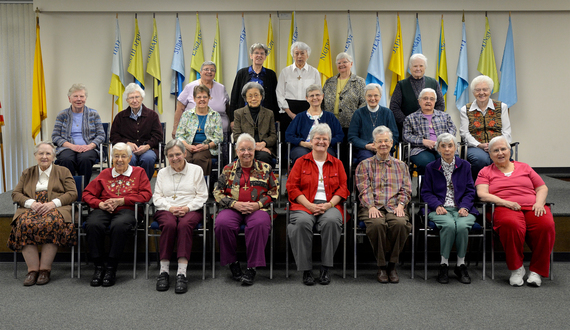 “It is a gift to be a part of an international order. You can’t be on the side of the poor only in your head. To have their firsthand experience is just such a gift and very moving,” reflects Sr. Carol Lichtenberg, SNDdeN, Provincial of the Ohio Province for the Sisters of Notre Dame de Namur.
“It is a gift to be a part of an international order. You can’t be on the side of the poor only in your head. To have their firsthand experience is just such a gift and very moving,” reflects Sr. Carol Lichtenberg, SNDdeN, Provincial of the Ohio Province for the Sisters of Notre Dame de Namur.
About the Sisters of Notre Dame de Namur
More than 175 years ago, eight Sisters of Notre Dame de Namur came to the United States from Belgium to help teach immigrant children. They brought with them their dedication to making known God’s goodness, especially among the poorest and most abandoned.
Since then, the Sisters have served the poor on five continents – in classrooms, in halfway houses, in inner-city community centers, and in rural village communities. The Sisters have taught in hundreds of schools across the United States. They arrived in the Archdiocese of Baltimore in 1934 and have staffed 15 different schools, reaching thousands of students from kindergarten to college.
“One of the things we often say is, ‘Where any Sister of Notre Dame is, each of us is,’” explains Sr. Carol. “So you feel like you are able to be helping in that place in the Congo, or in the new school in the Nigerian province, no matter where you are ministering.”
Caring for Others… and for One Another
The Sisters of Notre Dame de Namur receive no support from any diocese where the Sisters live and serve. This means they are entirely responsible for their mission and ministries, which includes caring for the frailest Sisters.
Last year, the Knott Foundation awarded a grant of $100,000 to support the retirement needs of the approximately 30 elderly Sisters residing at the Villa Julie Residence in Stevenson, Maryland where the median age is 85. The residence was purchased by the Order in 1947 as a place to care for Sisters who were sick and is now used as a facility for retired Sisters before they require skilled care.
With a portion of the grant funds, the Sisters purchased reclining chairs with electric lifts for each room at Villa Julie. The chairs are designed to help with mobility, comfort, and overall health. When asked about the new chairs, one sister smiled widely and proclaimed, “They’re great! I sleep in mine too much!”
For women who have dedicated their lives to serving others, it is only fitting that they receive the same love and attention in their own times of need.
Sustained and Persevering Efforts
“Our foundress St. Julie Billiart’s most characteristic virtues were simplicity, obedience, charity, and confidence,” states Sr. Carol. St. Julie was a strong woman and followed God’s call to serve others with conviction, saying: “God asks of us not promises, but efforts – sustained and preserving efforts.”
Today the Sisters continue to embody the virtues of their foundress and live out the charge of the Sisters of Notre Dame de Namur in their work as teachers, as ministers to the poor, and as prayerful ambassadors. They remain humble servants of the Lord who accept “the grace of the charge” with incredible passion and joy, from beginning to end.
By Kelly Medinger
12-22-2015
Everyman Theatre uses arts and humanities grant to find new ways to serve deaf and hard-of-hearing patrons
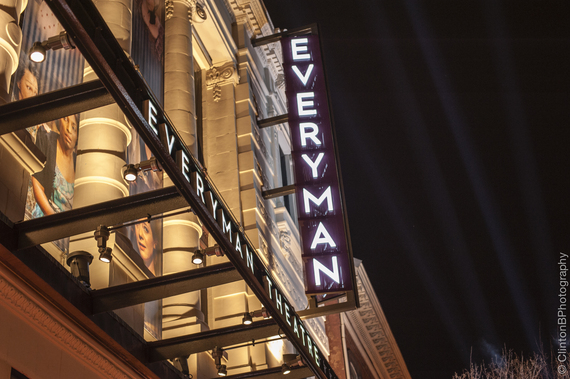 “What we strive for on stage is truth – finding a way to present something that is authentic,” proclaims Jonathan K. Waller, Managing Director of Everyman Theatre in Baltimore.
“What we strive for on stage is truth – finding a way to present something that is authentic,” proclaims Jonathan K. Waller, Managing Director of Everyman Theatre in Baltimore.
That sense of authenticity reached new heights in Everyman’s production of Tribes in 2014, where a deaf actor portrayed Billy, a deaf protagonist, in a coming-of-age story about being deaf in a hearing world. Notably, the show came to represent a coming-of-age for the Theatre itself and an opportunity for them to reach new audiences.
A Locally Grown Gem
Founded in 1990, Everyman Theatre has grown significantly over the past decade. In 2012 Everyman moved from an old converted bowling alley on Charles Street to the Bromo Tower Arts & Entertainment District. Today, the Theatre brings six productions to nearly 50,000 patrons each year.
Amidst this tremendous growth, however, Everyman remains deeply rooted in Baltimore’s local landscape: they employ a professional, equity-level resident company of actors who live in City neighborhoods, who send their children to neighborhood schools, and who are very much a part of the fabric of the community.
Technology as a Connector
For a number of years, Everyman experimented with ways to better serve deaf and hard-of-hearing patrons. Providing live sign language interpretation for select performances and investigating full service captioning for the entire theatre were two such options. As a small, local theatre company, the challenge became finding a more permanent and sustainable solution.
Everyman leveraged the production of Tribes to do just that. With a discretionary grant from the Knott Foundation and support from individual donors, the Theatre licensed cutting edge closed-captioning software, purchased 20 iPod touch devices, and began offering closed-captioning for all theatre performances.
“Closed captioning is definitely a game changer in how numerous people can experience live theatre, whether they are deaf or hard-of-hearing,” states Waller. Patrons now have a direct experience with the actors, instead of having to rely on an interpreter who is often positioned away from the main action of the stage. And Everyman’s commitment goes beyond technology to encompass staffing, training, and culture shifts. For example, an employee has been added to the Theatre’s production staff exclusively to operate the captions during each performance, and the Theatre teamed up with the Hearing and Speech Agency to help train house staff on basic sign language skills.
Strengthening Community Engagement
“The whole experience with Tribes has really become a case study for Everyman in how to reach new audiences and enhance inclusivity,” shares Alexandra Price, Director of Development. “Since then we have created a whole new department around community engagement with a dedicated staff position.”
Adds Waller, “Everyman Theatre’s name harkens back to the Everyman Theatre in Liverpool, England, which was founded on the principle of taking stories of kings and queens and making them accessible to the masses. In that tradition, our mission to make theatre accessible to everyone was pushed forward in a significant way with Tribes.”
In the meantime, Everyman Theatre continues to bring truth to the stage. The only difference is more people are able to join in that experience.
By Kelly Medinger
10-05-2015
Marian House uses human services grant to create a brighter future for women and the world
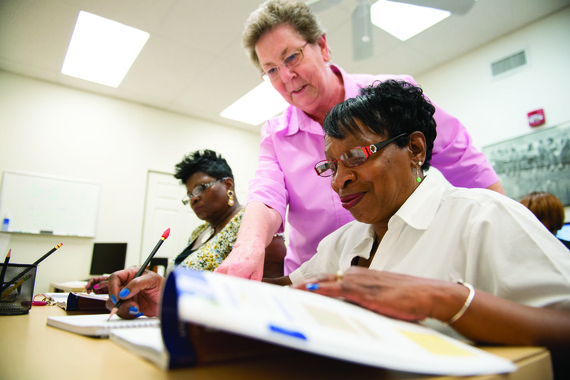 When Marian House opened its doors 33 years ago, their vision was to provide a brighter future to homeless women coming out of the prison system. Today, while Marian House has expanded to serve homeless women coming from multiple avenues, that vision has stayed true: to transform society by unlocking the potential of women who need a supportive place to live and heal.
When Marian House opened its doors 33 years ago, their vision was to provide a brighter future to homeless women coming out of the prison system. Today, while Marian House has expanded to serve homeless women coming from multiple avenues, that vision has stayed true: to transform society by unlocking the potential of women who need a supportive place to live and heal.
A Positive Transformation
The women living in Marian House’s transitional housing program are more than residents; they help run the organization. Residents staff the reception office – answering the phones and greeting visitors at the door – and they also cook dinner for each other every night and clean-up the kitchen afterwards.
“There are so many ways we’re trying to teach the women positive habits, from having dinner together, to recycling, to taking time to focus on their own personal development,” says Katie Allston, Executive Director.
Marian House’s rigorous program starts with an application, interview, and intake process, and women stay for an average of 11 months. “The women who come here are motivated to change their lives for the better,” adds Libby Keady, Grant Writer. “They have to demonstrate a capacity and drive to be a part of a structured program.”
Headquarters Upgrades
Marian House’s headquarters was built in 1928. It originally was used as a convent for nuns teaching at St. Bernard’s Catholic School across the street. The building now contains 29 single rooms, 4 family apartments, an education center, a commercial kitchen, a meeting room, and a large dining room for the women in Marian House’s transitional housing program, as well as space for approximately one dozen staff.
The Knott Foundation made a grant to Marian House to help install a new roof fitted with a state-of-the-art solar photovoltaic system on their headquarters building. Marian House’s headquarters now produces 75%-100% of its own energy. Any surplus energy is sold back to the power company, thereby creating a new revenue stream for the organization.
The Ripple Effect
Rooted in the Catholic tradition of their founders, the Sisters of Mercy and the School Sisters of Notre Dame, the work that Marian House does both to help homeless women and to be good environmental stewards has a broad positive impact.
“The focus of Marian House is to help women get back on their feet again, because women are often the primary teachers for their children. In that way, the ripple effect of Marian House is really quite extraordinary,” states Pete McIver, Director of Operations.
When talking about her time in the program, one resident reflects: “I now want a career, not just a job. It’s the first time I’ve had a chance to do that. ” Marian House has clearly helped her unlock her potential and envision a brighter future for herself.
By Kelly Medinger
09-17-2015
Saint Margaret Parish uses Catholic activities grant to replace aging roof
 Upon entering Saint Margaret Church, a magnificent prism of colorful stained glass shines over the baptistery. A large portion of the glass was actually closed off to direct sunlight until Saint Margaret replaced its roof and opened up the feature to natural light. “It has made such a difference for the presentation of this space,” proclaims Sandy Laird, Facilities Manager. “It was dark, and now it’s light and much more spacious.”
Upon entering Saint Margaret Church, a magnificent prism of colorful stained glass shines over the baptistery. A large portion of the glass was actually closed off to direct sunlight until Saint Margaret replaced its roof and opened up the feature to natural light. “It has made such a difference for the presentation of this space,” proclaims Sandy Laird, Facilities Manager. “It was dark, and now it’s light and much more spacious.”
Lighting the Way
Each weekend, 3,000 people attend Mass at Saint Margaret Parish, a Roman Catholic community with two locations in the heart of Bel Air, Maryland. As the largest parish in Harford County – and one of the largest in the Archdiocese of Baltimore – Saint Margaret serves as the center of Catholic spiritual life for thousands of families.
The pastor, Monsignor Michael Schleupner, explains the overall design of the worship space: “When you’re walking from the narthex into the sanctuary, the surrounding stained glass panels have a water-like effect. It’s as if you’re walking through the waters of baptism, which you need before entering the church to receive the sacrament of the Eucharist.”
Raising Support
Replacing the 30-year-old roof of the church was the first phase of a larger renovation project at Saint Margaret, partially funded by an even larger campaign for the entire Archdiocese. “We raised a record amount of money from this parish for the Archdiocesan campaign, while also raising money for our own capital needs,” shares Monsignor Schleupner.
“While we’re a large parish, we’re still a working class parish,” Monsignor Schleupner states. Support for the campaign is evident among a wide base of donors, who have all contributed what they can to make the church’s dream a reality. Among those donors, Saint Margaret received a capital grant from the Knott Foundation to help replace the aging roof. In this case, the construction project not only fortified the building, but also brought a new element of light and beauty to the entrance of the church.
Building Community
Community building is an integral part of the Catholic Church’s mission, and the campaign and renovations of Saint Margaret have brought the parish community together in multiple ways. For a time, parishioners attended Mass in the school gym, which the Liturgy Committee transformed into a worship space. People not only continued to come to Mass at Saint Margaret throughout the renovations, but many made personal gifts to the campaign.
With a new roof and other infrastructure upgrades, Saint Margaret Parish has turned its attention to enhancing the feeling of fellowship in the interior church. It is this strong feeling of communion with God and one another that makes Saint Margaret the spiritual home for so many Catholic families throughout Harford County.
By Kelly Medinger
05-19-2015
Brook Lane Health Services uses health care grant to construct a new hospital wing for children
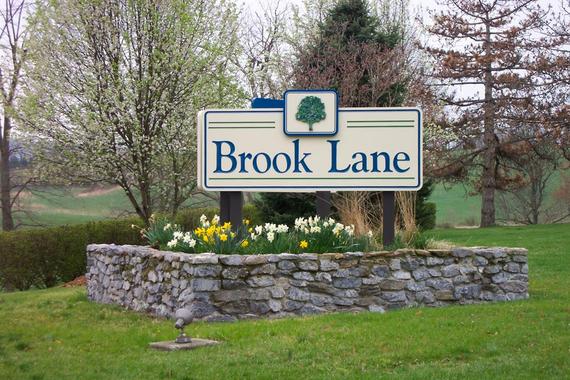 When a single mother whose six-year-old son was in need of inpatient mental health services in Hagerstown and there was no bed available at Brook Lane, the child and his mother were taken by ambulance to the next nearest in-patient facility, 75 miles away. Once the child was admitted there, the mother had to find affordable transportation back to Hagerstown, and then negotiate trips back and forth to Baltimore to be with her child, all while keeping her job.
When a single mother whose six-year-old son was in need of inpatient mental health services in Hagerstown and there was no bed available at Brook Lane, the child and his mother were taken by ambulance to the next nearest in-patient facility, 75 miles away. Once the child was admitted there, the mother had to find affordable transportation back to Hagerstown, and then negotiate trips back and forth to Baltimore to be with her child, all while keeping her job.
Kids Need Room Campaign
Located in Hagerstown, Maryland, Brook Lane offers a continuum of mental health services for children, adolescents, and adults. It is the only inpatient psychiatric facility for children and adolescents in the Western Maryland region.
In 2013, Brook Lane turned away 732 children and adolescents because all of their beds were full. A child who is turned away must remain in the emergency room until a bed is available, travel an hour or more to the nearest alternative facility, or return home without treatment.
To help kids get the specialized care they need and better serve families in the region, Brook Lane launched the Kids Need Room campaign. The campaign’s cornerstone was the construction of a new hospital wing with 14 single occupancy rooms for children. Brook Lane raised just over $2 million for the project, including a capital grant from the Knott Foundation.
More Room to Help People
When the new hospital wing opened in 2015, the number of beds available at Brook Lane increased from 43 to 57. Twenty-five staff were added to accommodate the growth in patient census and facility upkeep. This extra capacity allows them to care for 400 to 500 more children and adolescents each year, greatly reducing those who must be turned away.
Intakes at Brook Lane are done 24 hours a day, 7 days a week, where patients receive crisis stabilization in a safe and therapeutic environment. Kids most often come directly from the emergency room at a hospital with diagnoses of bipolar disorder or major depression, and they stay an average of six to eight days before being released with a treatment plan.
Saving Lives One Room at a Time
Over the past 65 years, Brook Lane has provided education and treatment to improve patients’ emotional and behavioral well-being. “We’re saving lives. We’re making lives better for people who are dealing with mental illness, whether it’s a coping skills issue, a behavioral issue, or a chemical imbalance,” says Kay Hoffman, Director of Development.
“When they find out where I work, people often joke by saying, ‘Save me a room!’” says Hoffman. “I always respond, ‘Do you know how lucky you are that we even have a room?” Indeed, the mother from Hagerstown whose son ended up in Baltimore is a fitting depiction of how Brook Lane can make a difference, one room at a time.
By Kelly Medinger
05-19-2015
Notre Dame Prep uses education grant to construct a new center on campus dedicated to science, technology, engineering, art, and math
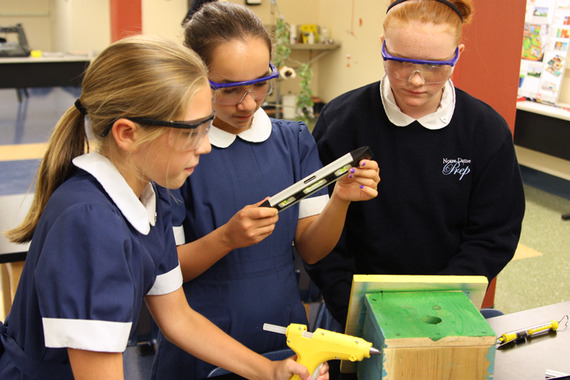 Two students, Francesca Zink ’16 and Victoria Niller ’16, stand in a room full of students and talk excitedly about robotics. They explain that last year they teamed up and designed a robot named Tank the Shark. While it took only three days to design Tank, it took months to construct him, wire him to a control panel, master how to power his movements, and give him a distinctive personality. This year they have teamed up again, and their robot’s movements are automated by a computer program they wrote. (In a show of Maryland pride, he’s a racehorse with a Preakness theme.)
Two students, Francesca Zink ’16 and Victoria Niller ’16, stand in a room full of students and talk excitedly about robotics. They explain that last year they teamed up and designed a robot named Tank the Shark. While it took only three days to design Tank, it took months to construct him, wire him to a control panel, master how to power his movements, and give him a distinctive personality. This year they have teamed up again, and their robot’s movements are automated by a computer program they wrote. (In a show of Maryland pride, he’s a racehorse with a Preakness theme.)
About NDP and STEAM
At Notre Dame Preparatory School (NDP), a Catholic school for girls in grades 6-12 sponsored by the School Sisters of Notre Dame, students have a multitude of opportunities to interact with the worlds of science, technology, engineering, art, and math, or STEAM.
In 2014, the Knott Foundation helped to fund the construction of a new STEAM center on campus. The center is a glass-enclosed space peppered with state-of-the-art equipment and bustling with activity. “At least once a day someone stops in front of the glass to see what’s happening,” shares Patrick Cusick, Engineering Teacher.
Interest in engineering at NDP has skyrocketed in recent years. In 2012, 11 students were enrolled in Introduction to Engineering. Four years later that number is projected to be 54 students in the introductory class and an additional 12 in Design/Build Engineering, the more advanced course.
Fostering Teamwork
Yet engineering is not a singular effort. It is about teamwork, including understanding and communicating the team’s product and process for getting there. Francesca adds, “Engineering isn’t just math and science. It’s also people skills. You really need to explain what you’re doing, and NDP prepares us well for that.”
“Everyone puts their part into the team,” Francesca notes. “I think that’s so cool about engineering. You’re not just in your cubicle; you’re bouncing ideas off each other.”
Engaging Students
The teamwork at NDP goes beyond the students and encompasses the faculty and academic departments as well. Taking an interdisciplinary approach, STEAM subjects are incorporated into the humanities (for example, students 3D print the skull of Yorick from Hamlet) and the theatre program, where engineering students conceptualize and construct set designs for the theatre program.
While the STEAM program and center at NDP provide the skills, awareness, and confidence for girls to excel in these subjects, the benefit extends beyond these areas. “What strikes me the most is the joy,” declares Marianne Reichelt, Acting Principal. “The students in the STEAM center are always energetic and engaged. It’s the classroom where the students are the most excited.” Victoria agrees: “The engineering class is the reason I decided to come to NDP.”
By Kelly Medinger
11-03-2014
Boys Hope Girls Hope of Baltimore uses education grant to inspire, empower, and nurture scholars to succeed in school and in life
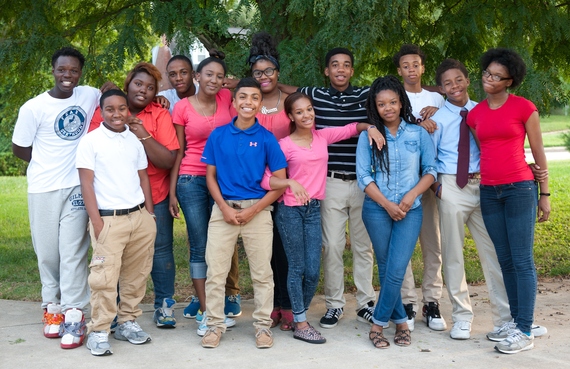 Living up to the organization’s tag line to “inspire, empower, nurture, succeed,” Boys Hope Girls Hope was founded by a Jesuit priest in 1977 to help academically capable and motivated children-in-need meet their full potential by providing them with an excellent education and a nurturing home. The Knott Foundation has supported their work since Boys Hope Girls Hope came to Baltimore in 2002, most recently with a grant to help pay educational expenses for their 16 scholars, including books, uniforms, field trips, and transportation.
Living up to the organization’s tag line to “inspire, empower, nurture, succeed,” Boys Hope Girls Hope was founded by a Jesuit priest in 1977 to help academically capable and motivated children-in-need meet their full potential by providing them with an excellent education and a nurturing home. The Knott Foundation has supported their work since Boys Hope Girls Hope came to Baltimore in 2002, most recently with a grant to help pay educational expenses for their 16 scholars, including books, uniforms, field trips, and transportation.
Inspire
Scholars are referred to Boys Hope Girls Hope (BHGH) by teachers, guidance counselors, and social service agencies who see both potential in a child and barriers to their success, such as economic hardship, domestic abuse, or poor supervision. After extensive psycho-educational evaluations, several visits to the BHGH homes, and in close partnership with the child’s parents, the student moves in.
This year, two new scholars joined BHGH. With the encouragement of her middle school guidance counselor, Brianna, now a freshman at Cristo Rey Jesuit High School, lobbied her family to allow her to join the program. While she admits it was hard to leave her mom, grandmother and sister, after just four months at BHGH Brianna already feels at home: “I see Boys Hope Girls Hope as a second family. The other girls in the house are my big sisters.”
Empower
Once a new scholar moves in, BHGH staff helps identify a private college-preparatory school in the Baltimore area that best fits the scholar’s academic needs and interests. Outside of school, scholars are encouraged to expand their horizons through service, job opportunities, sports, travel, and music.
“The community service we do comes from our foundation of faith,” says Jennifer Meyerhoff, Development Director. Scholars volunteer at local nonprofits including Beans & Bread and First Fruits Farm, and they work at places like Downtown Sailing Center and WYPR. In addition, they take part in many extra-curricular activities. Joshua, a freshman at Gilman School, plays four instruments and also plays lacrosse with a program called Next One Up.
Nurture
A typical day at BHGH begins with a 6:00 wake-up call. All the scholars leave for school at 6:45. Dinner is at 6:30, followed by two hours of required study time. Lights are out by 9:30 for middle schoolers and 10:30 for high schoolers.
While their days are highly structured, building scholars of character and compassion also comes from nurturing one another. As the oldest of five children, Noe, a junior at Calvert Hall College High School, grew up caring for his younger siblings. “Noe is now a leader among the boys in the house and takes his role as the oldest male scholar very seriously,” says Meyerhoff.
Succeed
Scholars from BHGH go on to achieve great things in life. Dwayne, a junior at Loyola University Maryland, recently became BHGH’s first scholar to study abroad. Another scholar, David, recently graduated from Morgan State University with a Master’s Degree in Social Work and is working full-time. A current scholar, Cierra, is a senior at the Institute of Notre Dame with hopes of studying engineering in college. She sums up the program like this: “Boys Hope Girls Hope is like co-parenting. It is truly a partnership between the program, the parent, and the scholar.”
Photo Credit: Stevie T. Photography
By Kelly Medinger
10-30-2014
Fire Museum of Maryland uses arts and humanities grant to put a spotlight on technology, democracy, and heroism
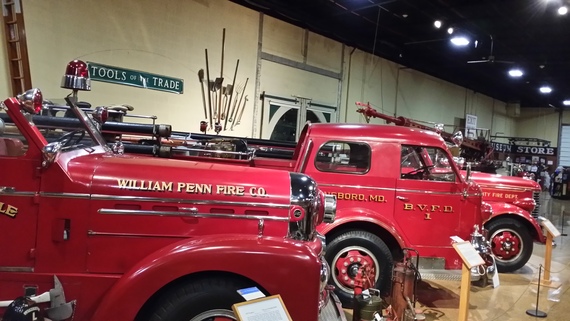 Standing in front of the new Fire Alarm Office at the Fire Museum of Maryland, a group of school children chant, “911, fire! 911, fire!” They clearly know who to call and what to say when they see a fire.
Standing in front of the new Fire Alarm Office at the Fire Museum of Maryland, a group of school children chant, “911, fire! 911, fire!” They clearly know who to call and what to say when they see a fire.
A Story about Saving Lives
Founded in 1971, the Fire Museum appears to be one of Baltimore’s best kept secrets. It is one of the largest fire museums in the country and holds some of the oldest pieces of fire equipment. “Together our 41 pieces tell the story of American urban firefighting,” shares Steve Heaver, Director and Curator of the Museum. “It is the story of how people help people. How they save their lives.”
Each year more than 12,000 people come to the Fire Museum to tour its collection, conduct research in its archives, participate in a special event, or even celebrate a birthday party. The Museum relies on a team of approximately 25 people, half of them volunteers, to keep things running smoothly.
Even with a small budget and a small staff, Heaver has a big vision: double the number of visitors to the Fire Museum to 25,000. He estimates that they can achieve this goal without increasing staffing or overhead, simply by taking advantage of economies of scale. “It’s not beyond the realm of possibility,” he says with a smile.
A Path of Technological Innovation
Walking through the museum is like taking a step into the history of fighting fire. Visitors follow a path of technological innovation from the earliest years of hand drawn firefighting (1654 – Civil War), through the horse drawn period (1852 – World War I), and then finally the motorized era (1906 – present). Each piece of the collection is cared for and restored by the staff and speaks to the ingenuity of humankind. Many pieces in the collection are even from our own backyard – Baltimore City, Boonsboro, Ellicott City, and the Violetville neighborhood, to name a few.
The Knott Foundation recently helped the Fire Museum renovate lighting for its exhibit space. With this grant and gifts from multiple other donors, the Museum replaced all of its 1971 fluorescent lamp fixtures and installed new LED lights as well as some track spot lights. “The new lights not only save energy and keep the artifacts from fading, they are much more visually pleasing,” Heaver comments.
By telling the story of American urban firefighting, the Fire Museum manages to be so much more than a museum: It becomes a lesson in democracy and making decisions. It serves as an example of technology improving peoples’ lives. And it ultimately stands as a witness to heroism.
By Kelly Medinger
08-26-2014
Mt. Washington Pediatric Hospital uses health care grant to “grow their own” pediatric specialty nursing workforce
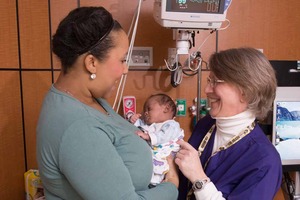 Caring and nursing are synonymous in our society. Yet to be caring specialists for patients, nurses need a support system of their own. That is how the Grow Your Own program at Mt. Washington Pediatric Hospital in Baltimore got its start.
Caring and nursing are synonymous in our society. Yet to be caring specialists for patients, nurses need a support system of their own. That is how the Grow Your Own program at Mt. Washington Pediatric Hospital in Baltimore got its start.
What is Grow Your Own?
Grow Your Own (GYO) is a pediatric nursing professional development program that includes a year-long residency for new nursing graduates or those new to pediatrics. It includes an orientation curriculum with classes like “Flu and Electrolytes” that utilize case studies and a simulation lab to foster problem solving, critical thinking, and technical skills. Interdisciplinary team building is another component of the program. Once a month, a “Mock Code” takes place in the simulation lab to improve communication between healthcare team members. Finally, GYO supports ongoing professional development for nurses at all levels by providing accredited continuing education courses and preparation for pediatric specialty certification.
“Change is constant in health care,” remarks Sharon Meadows, MS, RN-BC, Director of Education & Professional Development. “There is always new knowledge and new evidence out there to be integrated into practice.” Add to that the hyper-specialized nature of pediatric transitional care, and the need to “grow your own” team of highly-trained nurses becomes even more important.
About Mt. Washington Pediatric Hospital
Founded in 1922, Mt. Washington Pediatric Hospital was one of the first healthcare institutions in the United States devoted solely to the care of children. In their early years, they saw children suffering from rheumatic fever, polio, and influenza. Today, they serve 7,500 children each year for conditions such as feeding disorders, congenital challenges, diabetes, and more.
In many ways, Mt. Washington Pediatric Hospital is the bridge between a child’s stay in a more medically-intensive environment, like the ICU, and the child’s home. This transitional care environment means that the hospital’s medical staff work closely with parents to make sure each child’s healing continues well beyond the hospital stay.
From Pilot to Permanent
Since beginning as a pilot in 2009, the GYO program has exhibited impressive results in helping the more than 100 nurses at Mt. Washington Pediatric Hospital learn and grow.
During the year the Knott Foundation supported GYO, the 12-month retention rate for new nurses was 100%, compared to just 50% prior to GYO’s founding. Meanwhile, 10 nurses received their specialty certification. These positive results have persisted. The hospital now boasts nursing retention of 100% at 6 months, 95% at 12 months, and 83% at 18 months. Also, the number of certified nurses has grown to reach 30% of their nursing workforce.
With a track record of consistent, positive results, the GYO program has gone from being a pilot program supported by grant funding to being a permanent program sustained by the hospital’s budget. “Grant funding allowed us to build the program and demonstrate success for a few years. We couldn’t have done what we did without grant support,” Meadows recalls.
Reflecting on the GYO program’s impact, Meadows says: “The whole Grow Your Own program has really increased the level of expertise in our hospital and helped us retain our new nurses. This helps improve the quality of care and safety of our patient population – which is really what we aim to do in the education department. We help our staff be experts at what they do.”
By Kelly Medinger
05-16-2014
The National Shrine of Saint Elizabeth Ann Seton uses Catholic activities grant to build a successful retreat program
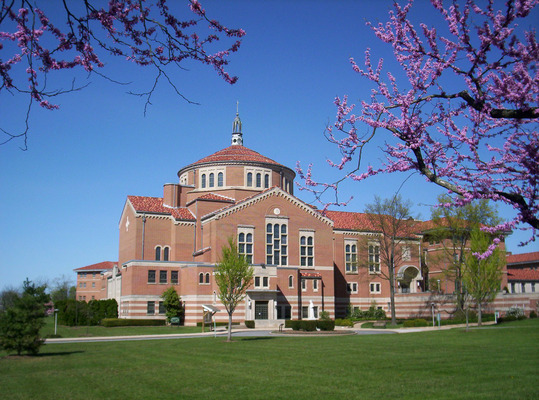 “Sacredness is a big part of why people like to come to Mother Seton’s Shrine,” says Rob Judge, Executive Director of the National Shrine of Saint Elizabeth Ann Seton. “That sense of peacefulness and sacredness permeates this place.”
“Sacredness is a big part of why people like to come to Mother Seton’s Shrine,” says Rob Judge, Executive Director of the National Shrine of Saint Elizabeth Ann Seton. “That sense of peacefulness and sacredness permeates this place.”
About the Shrine
Located in Emmitsburg, Maryland, the mission of the Shrine is to promote the life and legacy of Mother Seton, the first native-born Catholic American saint, as a source of inspiration and encouragement for all people. The Shrine is home to a museum and historical grounds that pay tribute to the life and work of Mother Seton, and a Basilica where she is laid to rest.
Today, the Shrine welcomes more than 45,000 visitors each year. Additionally, approximately 60 religious sisters reside on the campus of the Shrine. “Through our work, the sisters hope that more people will be drawn to the Shrine, that their experience will bring them closer to God, that they will see Mother Seton’s witness of charity to the poor, and that they will go home and want to live that out in their own lives,” Judge says.
Building the Retreat Program
To further its mission, the Shrine recently expanded its day retreat program with support from the Knott Foundation. From large confirmation retreats with 80 eighth graders, to faculty and staff retreats from area Catholic schools, to small parish groups, the Shrine is now a bustling retreat center.
During the grant period, the Shrine held 29 retreats, up from 6 retreats the previous year. With an average retreat size of 35 people, the program also brought many new visitors to campus. Overall visitorship to the Shrine increased significantly during the grant period. The upcoming 40th anniversary of the canonization of Mother Seton will offer a unique opportunity to continue to grow the retreat program.
Connecting the Dots
“When the groups are here, they’re able to spend time in the museum, watch the orientation film about Mother Seton, take a walking tour through the historic campus, attend Mass in the Basilica, and make private devotions in the chapel,” remarks Erica Colliflower, Retreat Coordinator. Notably, most organizers indicate that they would have hosted their retreat at a hotel, or not at all, if it were not for the Shrine’s retreat facilities.
“Being able to take advantage of all of these different services we offer really connects the dots for our retreatants,” Colliflower continues. “They see the whole picture and are able to walk with Mother Seton along her journey as a convert, a mother, a widow, a foundress, and a saint.”
By Kelly Medinger
05-16-2014
Adoptions Together uses human services grant to help foster children in Baltimore City find permanent connections as they age out of the system
 Turning 18 is a rite of passage for any young person, but it can be especially perilous for those in foster care.
Turning 18 is a rite of passage for any young person, but it can be especially perilous for those in foster care.
“Studies show that kids aging out of foster care without a permanent point of contact are much more likely to end up homeless within 18 months, have interactions with the justice system, face lower job prospects, and have fewer future educational opportunities,” shares Jeanette Stoltzfus, Manager of Corporate and Foundation Relations.
Adoptions Together and the Family Find Program
With a mission to build healthy, lifelong connections between children and families, Adoptions Together launched a program in 2011 to connect youth in Baltimore City aging out of foster care to a permanent relationship. The program, called Family Find Step Down, intersects the fields of social work, law enforcement, and investigations to produce the best result for a child.
“Every person needs someone to celebrate a holiday with and someone who will support them when they need it,” Stoltzfus explains. Adoptions Together begins that search by asking the child who they want that person to be. Sometimes it is a family member, and sometimes it is a teacher, a mentor, or a friend. For children who have been in the foster system for a long time, locating that person can be time consuming.
The Process of Finding People
Enter Dana Smoot, retired Maryland State trooper and criminal investigator. Through a grant from the Knott Foundation, Smoot was brought on to launch an “extreme recruitment” program where Adoptions Together works with Baltimore City Department of Social Services to link foster children to lifelong family connections.
“Basically, my job is to find people,” Smoot says. “While social workers provide direct services to children and families and law enforcement officers are out on the street, I am at my desk and able to devote my time to being analytical and persistent in locating the right people.” Smoot then passes along contact information of the people she has found to social workers who begin the process of engagement and building a permanent connection for the youth in care.
Producing Results
Her work has paid off. During the year-long grant period, Smoot conducted more than 2,300 searches and provided more than 300 prospective leads to child welfare professionals, which eventually helped to link 50 foster youth to a healthy, lifelong connection. After the Foundation’s funding expired, Adoptions Together, Baltimore City Department of Social Services, and the State of Maryland all recognized the benefits of the position and agreed to invest in the Family Find Step Down program.
Seventeen-year-old Daryl entered foster care at age two and is one of Adoptions Together’s clients. Daryl longed to connect with his birth family but didn’t know much about them, much less how to find them. Using a variety of medical records, court documents, and private and public databases, Smoot located Daryl’s mother and three of his siblings. Since then, Daryl and his mother are in weekly phone contact.
Daryl turns 18 soon and is lucky to have a new family to celebrate holidays with: his own.
By Kelly Medinger
11-12-2013
St. Elizabeth School uses education grant to purchase SMART Boards
 The hallways of St. Elizabeth School bustle with activity as students return to class after lunch in the cafeteria. In some ways, it seems like a typical school, but in other ways, it feels more special than that.
The hallways of St. Elizabeth School bustle with activity as students return to class after lunch in the cafeteria. In some ways, it seems like a typical school, but in other ways, it feels more special than that.
A Special Place
St. Elizabeth School, a ministry sponsored by the Sisters of St. Francis of Assisi, opened in 1961. Today, the School serves 120 students in the Baltimore metro area, ages 6-21, who have been diagnosed with disabilities such as autism, traumatic brain injury, emotional disabilities, intellectual disabilities, orthopedic or other physical impairments, or multiple disabilities.
“Every child with special needs deserves an appropriate education, and at St. Elizabeth School, we do more than that,” affirms Christine Manlove, Ed.D., Executive Director. Oftentimes students have struggled in other environments but flourish at St. Elizabeth, benefiting from skilled teaching, onsite clinical and therapeutic services, integrated use of assistive technology, a robust workforce development and transition program, and above all, an atmosphere of mutual respect and a sense of belonging.
Investing in SMART Infrastructure
The Knott Foundation has awarded St. Elizabeth School more than $100,000 over the past decade for capital needs, academic programs, and technology purchases. Most recently, the School received a $45,000 grant to install SMART Boards in seven classrooms, which advanced their focus on integrating technology to improve students’ learning experience.
Witnessing a lesson on the SMART Board, it is clear that the interactive animation and instant feedback that the SMART Board offers captivates the students. “Hearing automatic applause in front of the whole class when choosing the right answer is uplifting and encouraging,” Dr. Manlove observes. “It’s different than a teacher simply saying ‘right answer’ or ‘good job.’”
SMART Measurement
St. Elizabeth approached measuring the impact of the SMART Boards in their classrooms in a unique way. Through pre- and post- surveys, and comparisons to behavioral incident reports filed through the national School-Wide Information Systems (SWIS) database, they were able to observe measurable improvements in both student behavior and time devoted to educational tasks when the SMART Boards were in operation.
For example, when a SMART Board is being used in the classroom, the number of behavior incident reports decreases by 28.5%. And better behavior means more time focused on task. St. Elizabeth estimates that they earn back nearly seven educational days from the use of the SMART Boards over the course of an academic year.
Dr. Manlove concludes: “Without technology, our students would be isolated from the world in so many ways. No one would know how brilliant they are. Technology has allowed us to give them the tools they need to realize their full potential.”
By Kelly Medinger
11-12-2013
The Star Spangled Banner Flag House uses arts and humanities grant to showcase Baltimore’s role in our nation’s history
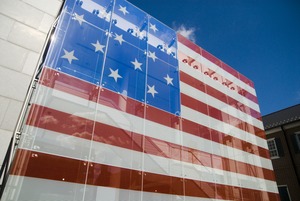 Sometimes we forget the importance that Baltimore plays in this nation’s history… and sometimes we can forget the role that museums, like the Star Spangled Banner Flag House, play in reminding us of this history.
Sometimes we forget the importance that Baltimore plays in this nation’s history… and sometimes we can forget the role that museums, like the Star Spangled Banner Flag House, play in reminding us of this history.
A Journey Back in Time
Touring the Star-Spangled Banner Flag House is like taking a 200-year journey through time and back again. On the Flag House’s campus in downtown Baltimore sits both a home built in 1793 and a modern museum that opened in 2004. Together, these buildings tell the story of the American flag that Mary Pickersgill sewed, which inspired the poem that became our National Anthem.
“Flags were a very important means of communication,” explains the museum’s docent. “They would signal everything from a company name, to a ship’s cargo, to a country’s land.” The American flag that Mary Pickersgill sewed came with special instructions: make a flag so large that the British could not miss it.
When it was finished, the flag measured 40 feet by 32 feet. Today, the Flag House’s campus contains a two-story Great Flag Window, which is the same size and design as the original.
Visiting the Flag House
Each year 12,000 visitors come to the Flag House to learn about domestic life in early America, the making of the Star-Spangled Banner, the War of 1812, and the writing of the National Anthem. More than half of these visitors are students from Baltimore City and Baltimore County. “In 2012, we saw a large uptick in the number of classes coming to the Flag House due to the bicentennial celebration of the War of 1812. Since then, our numbers have remained high,” shares Annelise Montone, Executive Director.
Over the past several years, the Knott Foundation has awarded the Flag House multiple discretionary grants to support the organization’s general operations and exhibits. The Foundation’s discretionary grant program provides awards between $500 and $2,500 and serves as a way for trustees to support organizations that most interest them – such as telling the story of Baltimore’s role in our nation’s great history to students and families who live here.
A New Exhibit
While telling a story that is 200 years old, the Flag House also has its eyes set on the future. On February 12, 2014, the birthday of Mary Pickersgill, a new permanent exhibit detailing Mary’s creation of the most famous flag in American history will open on campus. “It will be the first of its kind,” relays Montone. “There has never been a museum exhibit exclusively focused on this extremely important moment in history. We think it is high time there was.”
By Kelly Medinger
07-09-2013
Shepherd’s Clinic uses health care grant to serve those who need it most
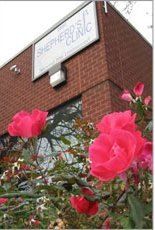 Since 1991, Shepherd’s Clinic has grown from a small medical clinic located in the basement of Seventh Baptist Church to an integrative health center recording, at its height, 18,000 volunteer hours and 9,440 patient visits in one year.
Since 1991, Shepherd’s Clinic has grown from a small medical clinic located in the basement of Seventh Baptist Church to an integrative health center recording, at its height, 18,000 volunteer hours and 9,440 patient visits in one year.
The Clinic serves patients whose income falls below 200% of the federal poverty index, and their catchment area includes the Waverly, Coldstream-Homestead-Montebello, Hampden and surrounding neighborhoods of Baltimore City.
A Mission Connection to Union Memorial Hospital
“The Clinic was originally founded to help the many non-urgent, uninsured patients going to Union Memorial’s emergency department,” shares Melissa DeLong, M.D., Medical Director. The connection to Union Memorial became deeper when Dr. William H.M. Finney, former Chief of Staff at Union Memorial, became the Clinic’s first volunteer Medical Director. “Dr. Finney set the tone for the Clinic, bringing an inspiring spirit of service and steadfast dedication to patient care,” DeLong remarks.
Today, Shepherd’s Clinic’s holistic approach to serving patients is a hallmark of the Clinic. Their campus includes a medical clinic, lab, as well as a full-service wellness center. The Joy Wellness Center offers psychiatric consultations, massage therapy, acupuncture, yoga classes, walking groups, and cooking lessons, among other things.
A Volunteer-Driven Clinic
Notably, all of Shepherd’s Clinic’s direct patient care services are provided by a vast and committed volunteer base. Volunteers range from the enthusiastic pre-med students from Johns Hopkins University manning the front desk, to the pharmacy students from Notre Dame of Maryland University’s School of Pharmacy, to the nurses, primary care physicians and specialists seeing patients every day.
The Knott Foundation has provided Shepherd’s Clinic with more than $180,000 since 2000, largely to support the Clinic’s general operations. During the most recent grant period, the Clinic saw record growth in patient visits – so much that the organization had to reaffirm its service area in the neighborhood to ensure continuation and quality of care as well as organizational stability.
Reform on the Horizon
Healthcare reform will mark another defining point in the Clinic’s growth and history. Many of Shepherd’s Clinic’s patients will be eligible for medical assistance under new federal guidelines, and others will be eligible for products on the healthcare exchange.
Even with these new measures in place, however, it is still expected that patients will experience gaps in coverage. Care will not be seamless, and people will still need an advocate to help them understand the system and reassure them that they will be taken care of. Shepherd’s Clinic will continue to meet the demand for free and affordable health care by adapting into a hybrid model that includes the existing free clinic for the uninsured, a new fee-based clinic, and a navigation service to help people acquire health coverage.
DeLong concludes, “While our model may shift some in the coming years, our mission to provide quality comprehensive care in the community to those who need it most will remain constant.”
By Kelly Medinger
05-15-2013
Ignatian Volunteer Corps uses Catholic activities grant to grow the number of volunteers in Baltimore
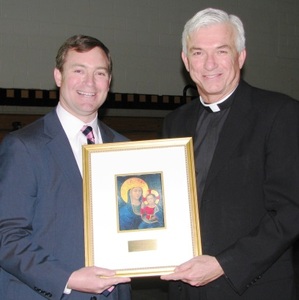 Love is shown more in deeds than in words,” St. Ignatius wrote. Today, the Ignatian Volunteer Corps lives out this principle by serving the poor, by working for a more just society, and by imparting the Catholic tradition of Ignatian spirituality.
Love is shown more in deeds than in words,” St. Ignatius wrote. Today, the Ignatian Volunteer Corps lives out this principle by serving the poor, by working for a more just society, and by imparting the Catholic tradition of Ignatian spirituality.
A national network, headquartered in Baltimore, the Ignatian Volunteer Corps (IVC) provides retired men and women opportunities to volunteer in their local communities while deepening their faith. Volunteers typically work two days per week in a social service agency and also participate in
organized group meetings and spiritual reflection exercises.
Growing the Number of Volunteers in Baltimore
The Knott Foundation made an early investment in IVC to help test their plans for dramatically increasing the organization’s number of volunteers. The grant allowed IVC’s Baltimore regional office – which had been in danger of closing – to hire a Regional Director who, in just one year, demonstrated significant results: Ten new volunteers recruited. Seven partner agencies added. An extra 4,500 hours of service performed. $20,000 in new partnership fees secured. And nearly $13,500 in individual gifts and fundraising event income raised.
These results, along with important data about the retiring population and rising social service needs, led IVC to launch a national campaign to raise $1 million and double the number of IVC volunteers over three years.
Launching a National Campaign
“The Magnify! Campaign recognizes the tremendous talent and opportunity that exists in the growing retired population,” states Mary McGinnity, National Executive Director. “Every day over the next two decades, 10,000 Baby Boomers will celebrate their 65th birthday. IVC is a great outlet for them to stay active, give back to the community, and grow in their faith.”
“Many IVC volunteers have lived their lives without really having known or worked with the poor,” continues Mary. “When they come to us, they are transformed through their experience.”
The Volunteer Experience
One such couple is George and Mary Jean Schuette, married 39 years, who joined IVC last year. George, a former Social Security employee, now works at Project PLASE, a housing and support services provider for the homeless. Mary Jean, a former Catholic school teacher, tutors GED students at Christopher Place Employment Academy, an intensive residential program for formerly homeless men. Each night George and Mary Jean recall the discerning question of their spiritual reflector, “Where do you find God in your work with these men?”
Sr. Marilyn Dunphy, MHSH, Baltimore’s Regional Director, sums it up: “Volunteer service in and of itself is wonderful. Volunteer service rooted in faith, like Ignatian spirituality, has a deeper meaning. Prayer and reflection allow our volunteers to take back a new understanding of, and a new perspective to, their work and their lives.”
By Kelly Medinger
05-15-2013
The League for People With Disabilities uses human services grant to generate jobs and revenue
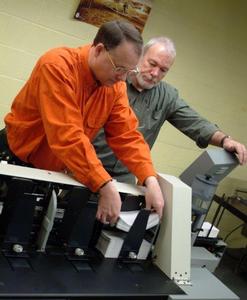 Words like “variable data printing” and “tray sequence numbers” are standard vocabulary at League Industries, a program of The League for People with Disabilities. As a full-service print and mail house operation, League Industries utilizes an array of commercial-grade automated equipment and an affirmative business model employing people with and without disabilities to do over $1 million of business every year.
Words like “variable data printing” and “tray sequence numbers” are standard vocabulary at League Industries, a program of The League for People with Disabilities. As a full-service print and mail house operation, League Industries utilizes an array of commercial-grade automated equipment and an affirmative business model employing people with and without disabilities to do over $1 million of business every year.
Taking League Industries from Small Shop to Big Business
League Industries was founded in 1933 to provide employment opportunities for people with disabilities. Over the past 80 years, the operation has evolved from a small workshop where people with disabilities constructed lampshades, to an affirmative, social enterprise that has successfully secured major direct mail and printing contracts from local, state, and private business entities.
The League for People with Disabilities (“The League”) offers individuals the opportunity to gain independence, increase self-sufficiency, and improve their overall quality of life through rehabilitative and support programs. League Industries is a special program of The League that provides employment for skilled individuals with physical, cognitive and neurological disabilities, while also helping to subsidize The League’s general programming.
“League Industries was founded as a way to keep people employed and perform job training. But it’s become a real social enterprise,” shares David A. Greenberg, CEO of The League. Indeed, League Industries’ business has grown 35% over the last two years. It generated nearly $170,000 for The League last year. “Frankly, the financial support from this operation helps us run important programs like our state-of-the-art wellness center and provide more scholarships to Camp Greentop, which are important to both our clients and the broader community,” remarks Greenberg.
How a Grant Augmented the Capacity of the Enterprise
The Knott Foundation has awarded more than $150,000 to The League since 2000. The most recent grant allowed League Industries to hire a Customer Service Representative and purchase commercial-grade mail house equipment, including a high capacity paper cutter, binding machine, printer and envelope inserter.
With the help of the added staff, League Industries was able to focus on more intense business development activities. Thanks to the Knott Foundation’s support, the added staff and machinery enabled League Industries to secure new, multi-year contracts worth over $250,000. Meanwhile, the new staff person was able to implement a more regular billing system, which reduced the number of outstanding account balances four-fold and increased the cash flow of the operation.
The benefits, however, extend far beyond financial subsidies. “Seeing League Industries makes you think about how important work is to life. In the typical workplace, you tend to hear people complain about work. But here, people love to work. Here, work is like gold,” says Greenberg.
By Kelly Medinger
11-16-2012
Junior Achievement of Central Maryland uses education grant to build financial literacy among Catholic school students
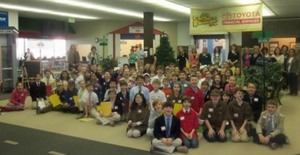 How many young people can calculate the value of a stock portfolio or define the difference between gross and net income? Nine in ten Catholic school seventh and eighth graders could, after participating in Junior Achievement of Central Maryland’s Finance Park program.
How many young people can calculate the value of a stock portfolio or define the difference between gross and net income? Nine in ten Catholic school seventh and eighth graders could, after participating in Junior Achievement of Central Maryland’s Finance Park program.
Making Smart Academic and Economic Choices
“At Junior Achievement, we give young people the knowledge and skills they need to own their economic success, plan for their future, and make smart academic and economic choices,” remarks Jennifer Bodensiek, President of Junior Achievement of Central Maryland (JA). JA’s programs are designed to deliver hands-on experiences that give young people the knowledge and skills in financial literacy, work readiness and entrepreneurship.
“JA helps students by supplying a real-world perspective that complements classroom learning,” Bodensiek says. “This approach is especially important given so many young people drop out or perform poorly in school because of boredom. This sense of boredom often stems from a disconnect between the classroom and the skills they perceive needing in the real world. The goal of JA programs and our cadre of trained corporate and community volunteers is to share life lessons to make learning come to life and be that connector between the classroom and the real world,” she adds.
Connecting with Young People
When it comes to connecting with more young people, JA has had great success. The organization currently serves 33,000 students annually in 12 Maryland counties, a 64% increase from the previous year. Over the last 15 years, the Knott Foundation has invested nearly $100,000 to support JA’s work in Catholic schools in particular. Most recently, a grant enabled more than 3,000 middle grade students and 800 elementary students to participate in JA’s two capstone programs, JA BizTown and JA Finance Park Virtual.
JA BizTown is an interactive experience where students visit a simulated town, work at assigned jobs, receive paychecks, buy and sell goods and services, and manage their business and personal finances. When students are older, they participate in JA Finance Park Virtual – a computer simulation where a student receives a unique profile (such as a married woman with two children making $40,000/year) and then plays the game of life, budgeting and investing her own money as various situations arise.
Taking the Program System-Wide in the Archdiocese
Notably, the Foundation’s grant was a key ingredient to helping take the JA Finance Park Virtual program system-wide in the Archdiocese of Baltimore. The program is now taught to all seventh grade math students throughout the Archdiocesan school system. Students’ reactions have been positive. A recent graduate of St. Stephens School in Kingsville who took part in JA Finance Park Virtual even told her former teacher, “Keep doing Finance Park because it has already helped me in high school!”
By Kelly Medinger
11-15-2012
Mother Seton School uses education grant to educate teachers and students
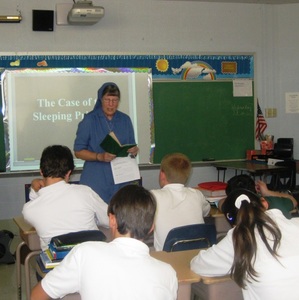 Some students use the classroom computer to print their homework because they don’t have a printer at home. Others need the computer for assistive technology to accommodate their learning needs. And yet others might use it to access an online dictionary and challenge a friend’s word during a heated Scrabble game. In all cases, students at Mother Seton School in northern Frederick County use technology in the classroom every day.
Some students use the classroom computer to print their homework because they don’t have a printer at home. Others need the computer for assistive technology to accommodate their learning needs. And yet others might use it to access an online dictionary and challenge a friend’s word during a heated Scrabble game. In all cases, students at Mother Seton School in northern Frederick County use technology in the classroom every day.
About Mother Seton School
Mother Seton School (MSS) is an independent Catholic school established by the Daughters of Charity in 1957. The School traces its roots back to St. Joseph Academy and Free School in Emmitsburg, which was founded 200 years ago by St. Elizabeth Ann Seton herself.
Today, MSS serves approximately 300 students in pre-k through eighth grade. The School is committed to St. Elizabeth Ann Seton’s legacy of providing Catholic education to students from families of diverse economic backgrounds, and as such, tuition is the lowest among all private schools in Frederick County.
From a Technology Grant…
With a grant from the Knott Foundation, Mother Seton School installed interactive ceiling mounted projectors in their remaining four classrooms without this equipment, purchased computer workstations for student use in each of the 16 classrooms, and provided staff development in instructional technology.
“The way I look at our school,” Principal Sr. JoAnne Goecke, D.C. shares, “is that it’s okay to take baby steps. The most important factor is to put real thought and planning into the purchases, and then to foster a culture among teachers of excitement and flexibility when it comes to new technology.”
To a Graduate Technology Course…
During the grant period, seven MSS faculty (which equates to one-third of their faculty) enrolled in a three-credit graduate course through Mount St. Mary’s University called “Integrating Technology into Instruction.” The course was offered on-site at the School. “We realized it would probably be more appropriate for the teachers in this building to have training using the technology they have here,” shares Laura Frazier, Ed.D., Assistant Professor of Education at Mount St. Mary’s University and MSS Technology Committee member.
To Technology Utilization in the Classroom
“The class inspired me to use more equipment and not be afraid of it,” one teacher who completed the course comments. Dr. Frazier adds that graduate instruction goes well beyond teaching the technology tools used in today’s classrooms: “We look at how each technology tool enhances student learning, and we talk extensively about instructional decision-making. Using technology for the sake of using technology is not a good reason to use technology,” she affirms.
Sr. JoAnne ends by offering a striking analogy to using differentiated technology tools in the classroom: “It’s somewhat like a chalkboard. Are you going to use colored chalk or plain white chalk? That was the question long ago. Today the question is, ‘What tools are we going to use to help the children facilitate their learning?’”
By Kelly Medinger
07-09-2012
The Red Devils use health care grant to support breast cancer patients in need
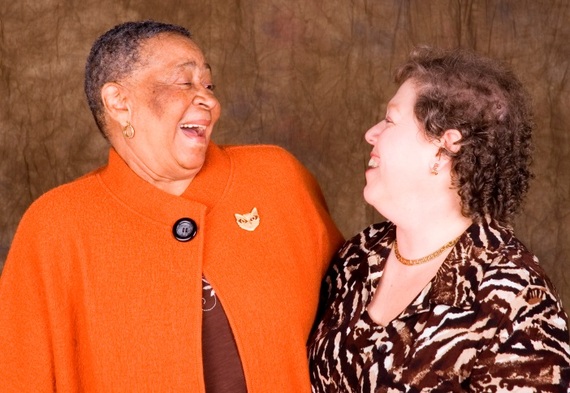 What does it mean to be a Red Devil?
What does it mean to be a Red Devil?
The name itself references the chemotherapy drug Adriamycin, commonly used in the treatment of a wide range of cancers including breast cancer.
It is also the title of Katherine Russell Rich’s spirited memoir about her own breast cancer treatment entitled The Red Devil: To Hell with Cancer and Back (Metheun, 2002). The book inspired the mother of breast cancer patient Jessica Cowling, and she later adopted the team name The Red Devils for the Susan G. Komen Race. When Jessica and her friend Ginny Schardt died of breast cancer, the organization The Red Devils was founded in their honor.
Serving Breast Cancer Patients throughout Maryland
Ten years later, The Red Devils serves nearly 700 breast cancer patients and their families each year. The organization’s geographic reach has grown from one hospital in Baltimore to 39 hospitals across Maryland. Notably, they are able to serve all of these patients with only two staff members and a network of hospital coordinators, namely nurses and social workers. “It’s a brilliant business model that was created by our founders and has served us well,” shares Janice Wilson, Executive Director, explaining that the organization dramatically limits its overhead by vesting certain decisions with professional staff at the hospital level.
The Knott Foundation has awarded The Red Devils $60,000 in operating support over the past five years, ultimately helping the organization grow from serving 500 patients in 2008 to nearly 700 in 2011. On average, The Red Devils provides each patient or family with $300 for critical needs, including transportation to treatment, family support, and medical costs.
Enhancing the Quality of Life
The support provided by The Red Devils enhances patients’ quality of life and promotes normalcy in a most traumatic time. “The Red Devils made it possible for survival. The pressure that I carried impacted my healing process. Your kindness and thoughtfulness gave me peace to heal,” commented one patient. Another simply stated, “I could not afford to go to my treatments without your support. You were a God send for me as I didn’t know what I was going to do.”
So what does it mean to be a Red Devil? It means a life-giving helping hand to someone in need. It means hope above despair. “Until there’s a cure for breast cancer, we need to be here,” Wilson concludes. “That’s why, for now, it’s great to be a Devil.”
By Kelly Medinger
05-15-2012
Sisters Academy of Baltimore uses education grant to support girls well beyond their years at the Academy
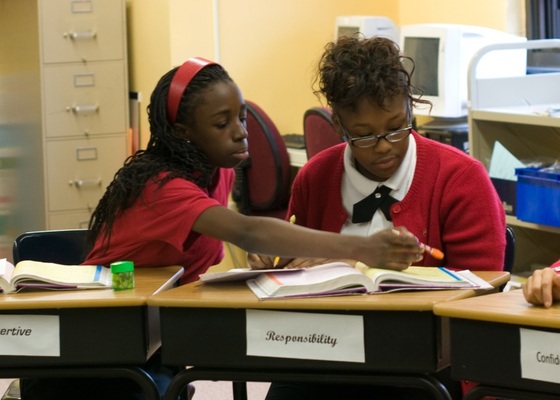 In 2004, four congregations of religious women came together to respond to the community’s call for an all girls’ tuition-free middle school in southwest Baltimore. The result was Sisters Academy of Baltimore – founded by the School Sisters of Notre Dame, Sisters of Bon Secours, Sisters of Mercy, and Sisters of Notre Dame de Namur – which now serves 63 girls in grades 5-8.
In 2004, four congregations of religious women came together to respond to the community’s call for an all girls’ tuition-free middle school in southwest Baltimore. The result was Sisters Academy of Baltimore – founded by the School Sisters of Notre Dame, Sisters of Bon Secours, Sisters of Mercy, and Sisters of Notre Dame de Namur – which now serves 63 girls in grades 5-8.
Working Together to Foster a Welcoming Spirit
“It has been a once in a lifetime opportunity, to work together as educators and begin something from nothing,” comments Delia Dowling, SSND, President. She describes the collaborative effort of the four congregations of sisters as “the wave of the future and the Church,” in that religious communities are “stepping beyond themselves” to help meet unmet needs in the world. In Sisters Academy’s case, the needs are especially poignant: the students primarily come from west and southwest Baltimore, low-income neighborhoods where nearly half of the adult population has less than a 12th grade education.
A welcoming spirit embodies the Academy. Every morning, the girls begin their day in the gathering space for prayer. One empty chair always sits in the corner. “It is there to show that we always have room for someone else, that we will always welcome a newcomer,” explains Kafui Anthony, an 8th grade student.
The Knott Foundation’s Deeply Rooted Support
Since Sisters Academy opened eight years ago, the Knott Foundation has provided $130,000 to the school in grant support, most recently awarding $40,000 in October 2010 to support three priorities – the graduate support program, technology instruction, and salaries for masters-level teachers.
The graduate support program is integral to Sisters Academy’s graduates’ success, helping them in the selection and application process for high school and college while also guiding them through life after Sisters Academy. Notably, during the grant period, all fifteen 8th graders were accepted to Catholic high schools and received adequate financial aid to attend. In addition, 2012 marks a special year for the school with its first class of alumnae finishing high school. These 10 young women have been accepted to such colleges as Notre Dame of Maryland University, Stevenson University, Saint Joseph’s University in Philadelphia, and Lebanon Valley College in Annville, Pennsylvania.
The Knott Foundation’s recent grant also supported the development of an integrated technology curriculum plan with specific learning goals by grade level. This planning helped, in part, to leverage $53,000 more in technology funding from sources such as the Abell Foundation and the University of Maryland BioPark.
Meanwhile, the grant supported two teachers who completed Operation TEACH, a post-graduate service program offered through Notre Dame University of Maryland where teachers earn their master’s degree while working in local Catholic schools. “In addition to developing capable and committed teachers, the program gave me a large teacher support system that doesn’t always exist in schools,” comments Regina Fabbroni, an Operation TEACH graduate who now teaches mathematics and social studies at Sisters Academy.
Transformative Education at its Best
In the end, Sisters Academy is about transforming girls’ lives, one at a time. One student who experienced particular hardships during her time at the Academy recently wrote to Sister Delia: “I look at where I am in my life today – the opportunities I have and doors that are opening up for me, and I ask myself ‘why me?’ …When I analyze just what was the pivotal factor in my life that set my success in stone – I know it was me attending and graduating from Sisters Academy.”
And so Sisters Academy’s mission of empowering girls to become agents of transformation in their families, communities, and society continues each day, with an open chair and a welcoming spirit for all who enter the school.
By Kelly Medinger
05-15-2012
Gilchrist Hospice Care uses health care grant to support pediatric hospice
 “To live – that’s really what we’re about. We don’t focus on the dying. We focus on enjoying what time remains,” declares Brenda Blunt, Gilchrist Kids Program Manager.
“To live – that’s really what we’re about. We don’t focus on the dying. We focus on enjoying what time remains,” declares Brenda Blunt, Gilchrist Kids Program Manager.
Gilchrist Hospice Care is the largest hospice provider in Maryland and serves 600 patients every day. Gilchrist Kids is a special program that serves pediatric patients. “One of the reasons we deliberately called the program ‘Gilchrist Kids’ and even created a different logo than the one used for our adult program is so that families didn’t have to see the word ‘hospice’ every day,” explains Brenda. Understandably, hospice is associated with the end of life and represents an especially difficult development for any family whose child is suffering from a terminal disease.
A Founding Supporter of Gilchrist Kids
The Knott Foundation was one of the founding supporters of the Gilchrist Kids program when it began in 2010. During the grant period, Gilchrist Kids grew from serving 4 patients to 15 patients per day.
The patients are most often referred from pediatric units at large Baltimore area hospitals such as Johns Hopkins, University of Maryland Medical Center, and Sinai Hospital. Approximately half of them have cancer, while the other half suffer from conditions including congenital anomalies, degenerative neurological diseases, AIDS, traumatic injuries, end-stage organ diseases, or rare genetic disorders.
Kids Just Want to Be Kids
Even though they are ill, most of the pediatric patients “still just want to be kids,” says Brenda.
So Gilchrist’s strong corps of volunteers helps each family to maintain a happy home life and sense of normalcy. A volunteer might decorate a child’s bed, bake cupcakes for school, cook dinner for the family, or even walk the family dog.
Beyond these volunteer efforts, the professional support Gilchrist Kids provides to families is exceptionally comprehensive: 24-hour on-call nursing visits; pain and symptom management; healthcare benefit navigation assistance; medication and medical supply delivery to the home; a child life specialist to work through complicated emotions with parents and siblings; bereavement support; and family and community outreach and education.
Pediatric Hospice Care – A Specialized Operation
It is important to note that the financial burden of running this type of comprehensive program is not light. Gilchrist Kids employs a team that includes a medical director and two medical consultants to oversee the staff: a neonatologist, a pediatric oncologist, and a general practice pediatrician, all with very specialized knowledge.
Moreover, their team of nurses, aides, counselors, and volunteers must travel to each child’s home to provide care. When compared to adults, it is estimated that these visits to pediatric hospice patients are twice as frequent and last twice as long.
The price of pediatric equipment is also very high – a pediatric hospice bed, for instance, can cost $12,000, and specially designed chest vests that help with breathing and secretions are $15,000. To help cover the multitude of uncompensated costs that arise, Gilchrist Kids must raise up to $200,000 every year.
Helping Those Who Need It Most
Yet all of these resources are priceless to each patient and family in the program. Brenda recalls one baby that Gilchrist Kids recently served:
When the baby was born, they didn’t expect him to go home. Two days later, the mom was ready to be discharged but she didn’t want to leave the baby in the NICU. She and her husband decided to call Gilchrist Kids, and we helped them bring their baby home. A couple days later, the mom said to us, “Wow, this is kind of fun – being a parent.” It turns out they had not prepared for being just “mom and dad.” They were first-time parents and were very grateful for all the help the nurses were providing, including education on normal baby care and how to bond with your baby. In the end, their baby lived for 12 days. When he died, the mom hugged me and whispered, “Thank you for taking something that could have been so horrible, and for making it not be.”
And that is the power of Gilchrist Kids: focusing on life and celebrating it until the very end.
By Kelly Medinger
05-04-2012
Catholic Community at Relay uses Catholic activities grant to create a new entrance to their church
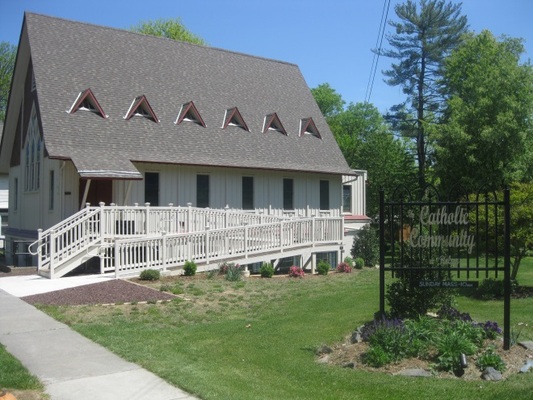 On the day of First Holy Communion, friends and family of the Catholic Community at Relay bounded up the steps to the small church to see their children, grandchildren, and even great grandchildren receive this important sacrament. Yet not all family members were able to climb the stairs, so some used the newly constructed ramp leading to the church’s entrance.
On the day of First Holy Communion, friends and family of the Catholic Community at Relay bounded up the steps to the small church to see their children, grandchildren, and even great grandchildren receive this important sacrament. Yet not all family members were able to climb the stairs, so some used the newly constructed ramp leading to the church’s entrance.
Building the Ramp
As with any church built in 1880, the Catholic Community at Relay (CCR) was peppered with steps and narrow passages until they embarked on a major renovation project to make the church more accessible to those with disabilities. The Knott Foundation helped fund the construction of a ramp leading up to the church’s entrance, which provides people in wheelchairs, with walkers, on crutches, or even those pushing strollers easy access to the worship space.
“A large part of my healing is being back in my faith community,” lifelong CCR member, Elise Cole, proclaims. Due to a knee injury, the young mother of three has relied on crutches for nearly a year, so she is especially grateful for the ramp.
In addition to solving a physical access issue, the construction project served as a community building experience for CCR. All 100 households belonging to the faith community, representing more than 250 individuals in total, contributed volunteer time and/or financial resources to the effort. Notably, CCR exceeded its fundraising goal for the work by 30%. And one CCR member even recruited a local Boy Scout to undertake the landscaping and hardscaping surrounding the new ramp as his Eagle Scout project.
Being an Intentional Eucharistic Community
CCR is an intentional eucharistic community located in the historic village of Relay, Maryland. It is ecclesiastically approved by the Archdiocese of Baltimore but different than a traditional parish. Visiting priests, usually from religious orders such as the Franciscans, Jesuits, or Trinitarians, celebrate mass on Sunday. Beyond that, each member of the community takes full responsibility for running CCR. “An underlying theme is that every member has a vested interest in the church. We are all responsible, from managing the finances, to emptying the trash, to cleaning the church. Volunteerism is something we see in every aspect of what we do,” states Greg Bean, CCR member.
Connie Maas, CCR member, concludes: “The words ‘faith community’ really sum it up. We are bounded by our faith, and we work together as a family to support each other, our own spiritual growth, and our commitment to actively carry out the message of Christ.”
By Kelly Medinger
03-15-2012
Second Chance uses human services grant to turn lives around
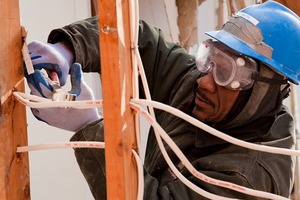 52,000 labor hours created. $3.2 million consumer dollars saved. 11 million pounds of landfill waste diverted. And that was just in one year!
52,000 labor hours created. $3.2 million consumer dollars saved. 11 million pounds of landfill waste diverted. And that was just in one year!
Founded in 2001, Second Chance provides people, materials, and the environment with “a second chance.” The organization deconstructs buildings and homes, salvages usable materials, and then sells them to the public. The sales proceeds funnel into their workforce development program, which provides job training and placement to those with employment obstacles in the Baltimore region.
Turning Job Training Into Social Benefit
“It was hard to fully appreciate the social benefit of what we do until the first four guys graduated from our job training program,” Mark Foster, Founder and Executive Director, says with emotion in his eyes. “Then I saw what it actually meant – to watch four guys completely turn their lives around.”
Yet the turn is not an easy one. Job trainees must pass a rigorous two-week evaluation and qualifying period, which includes life and safety skills development, and then embark on 16 weeks of on-the-job technical instruction in how to use numerous types of power tools, hand tools, and equipment. Upon completion of the program, qualified trainees receive additional, specialized training in lead abatement and other hazardous materials removal and handling, as well as forklift operation. And those motivated to advance further can go on to receive certificates in carpentry, restoration, manufacturing, plumbing, electrical and masonry. In the end, trainees are placed in green jobs at companies such as Hirsch Electric and Waste Management System.
Expanding All Under One Roof
With funding from the Knott Foundation, Second Chance expanded the capacity of its job training program from 10 new trainees in 2010 to 30 in 2011, and they grew to reach more than 50 in 2012. Even more impressive are the outcomes from the program: During the grant period, for example, Second Chance boasted a 100% graduation rate. Every graduate was placed into a green job, and 97% remained in their jobs after one year. Moreover, ten workforce trainees were promoted, resulting in a combined annual pay increase of $52,000.
Second Chance’s new headquarters located at 1700 Ridgely Street in South Baltimore has brought the organization’s retail operations, job training program, and central office all under one roof – a meaningful achievement for the growing nonprofit and social enterprise. “The general public comes to Second Chance to shop in the warehouse for home furnishings, architectural salvage materials, building materials, and kitchen and bath elements,” shares Foster. “What they may not know is the whole story of our organization – what we accomplish for the universal good of us all.”
By Kelly Medinger
01-03-2012
Friends of Patterson Park uses cash flow loan to boost operations
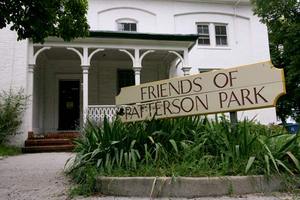 You might see them in chest waders scooping debris out of the lake with pool skimmers. Or mulching trees. Or inspecting playground equipment for safety. In all cases, the Friends of Patterson Park will be helping to steward the resource that is near and dear to their hearts: Patterson Park.
You might see them in chest waders scooping debris out of the lake with pool skimmers. Or mulching trees. Or inspecting playground equipment for safety. In all cases, the Friends of Patterson Park will be helping to steward the resource that is near and dear to their hearts: Patterson Park.
The Past and the Present
The first known resident of what is now Patterson Park arrived in 1669. A lot has happened in the last 340 years, and now Friends of Patterson Park, which was founded in 1998, is working with more than 600 volunteers to preserve and enhance all that the Park offers.
Kathy Harget, who joined Friends of Patterson Park as the new Executive Director in the summer of 2011, sees how the mission extends beyond the physical space: “The green spaces in our city are a perfect connector to bring neighborhoods together. Hosting the right programs can attract a whole lot of diverse people who otherwise may not have met each other.”
Transition to the Future
The Knott Foundation stepped in to help Friends of Patterson Park in late 2011 through a Program-Related Investment (PRI). PRIs, also referred to as cash flow loans, provide nonprofits with access to capital at lower interest rates and at shorter turnaround times than might otherwise be available. For Friends of Patterson Park, some of their fundraising activities, including a major event for corporate donors, had been delayed with the leadership transition, so the organization needed a boost to carry them through the fall.
The result? Friends of Patterson Park received a $25,000 loan from the Knott Foundation. With
sufficient financial footing, they were able to meet or exceed all of their fundraising goals, including hosting a corporate fundraiser that brought in $10,000 more than budgeted; receiving increased
annual grants from two foundations; exceeding individual giving goals with the help of the State’s tax credit program; and meeting a $15,000 matching grant from the Meyerhoff Foundation in just 45 days. The year finished with a cash surplus, and the Friends paid the loan back to the Knott Foundation early.
“This is a new chapter in the history of the Friends of Patterson Park,” states Harget. Indeed it is, and the Knott Foundation is honored to be a part of it.
By Kelly Medinger
11-15-2011
Meals on Wheels of Central Maryland uses human services grant to feed the hungry and homebound
Imagine if your shopping list included 1,250 lbs. of meat. Every day. That is the reality for Meals on Wheels of Central Maryland, the largest and longest continually operating Meals on Wheels program in the country.
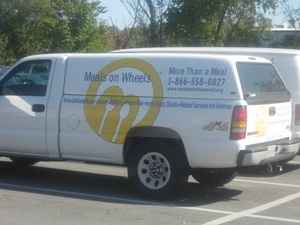 Feeding Those in Need
Feeding Those in Need
The central mission of Meals on Wheels is to feed those in need. Every day, more than 250 committed volunteers deliver a hot lunch and refrigerated dinner to approximately 1,500 people living in the Metro Baltimore area. These include the elderly and chronically disabled, as well as the temporarily disabled, such as those on bed rest during pregnancy or recovering from major surgery. Many times, the client’s only social contact outside the house is the Meals on Wheels volunteer who comes to visit each day during the week.
Fostering Life-Saving Relationships Between Volunteers and Clients
In fulfilling its core mission, Meals on Wheels is often so much more than just a conduit for sustenance – it’s a lifeline to the homebound. On Labor Day this year, a Meals on Wheels driver was delivering lunch and dinner to a woman living at home in a wheelchair. When he arrived at her house, she did not answer the door, and he could hear her crying out for help from inside the house. She had fallen out of her wheelchair on Saturday, and when he found her on Monday, she had gone 48 hours with no food, no water, and no ability to move or reach a phone to call for help. “The sad truth is that she probably would have died there, had it not been for Meals on Wheels,” relates Barbara Levin, Client Services Director.
“The volunteers and clients become quite attached to each other,” explains Ellen Falk, Volunteer Retention and Recruitment Coordinator. Volunteers often shop for clients, bring in their mail, take out the trash, and talk to them about their families. After excitedly telling clients about her daughter’s upcoming wedding, one volunteer brought her daughter and the wedding pictures on her route to share with clients. Then there is the exceptionally dedicated gentleman who volunteers all five days a week. He recently retired, and his wife of nearly 60 years told him he “needed to get out of the house and find something productive to do with his time.” Thank goodness for Meals on Wheels!
Starting in the Kitchen
Yet the good work that Meals on Wheels does out in the community starts inside the warehouse kitchen. In 2010, the Knott Foundation awarded a grant to meet a funding challenge from the France-Merrick Foundation, which enabled the organization to purchase a Cook-Chill System.
This impressive piece of machinery cooks large quantities of food and then chills it immediately. Meals on Wheels uses it to cook almost anything, most recently discovering that it is both cheaper and healthier to cook beans in the Cook-Chill System instead of purchasing the higher-sodium canned varieties. “And the best part is,” shares Kathleen Tinker, Food Services Manager, “the system can even cook overnight when no one is here.”
Meeting Ever-Growing Needs
Even with these advances, Meals on Wheels is still faced with the daunting task of meeting growing needs. With the aging population, the organization is projecting an explosion of demand over the next ten years. “The goal is to double the number of clients served by 2020,” states Toni Gianforti, Grant Writer.
The Cook-Chill System is one way they are increasing their capacity to produce more meals. Another way is through a new tray sealing process, funded by a $100,000 grant from The Walmart Foundation and the Meals on Wheels Association of America. Notably, the grant required a quick turnaround of a 10% match, and the Knott Foundation provided the initial $1,000, with the Board pledging the remaining $9,000. “The Knott Foundation provided the weight and leverage we needed to secure the rest of the funds,” Gianforti adds.
Thus, with an impressive history in Maryland and an ambitious charge for the future, Meals on Wheels continues to help homebound people eat well, live independently, and enjoy peace of mind.
By Kelly Medinger
05-20-2011
St. Francis Neighborhood Center uses education grant to empower students
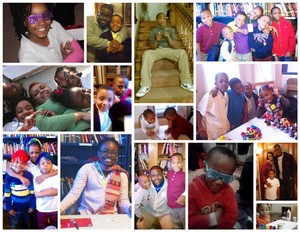 When Shawn came to St. Francis Neighborhood Center two years ago, he was failing the fourth grade. He was a bully at school. And he was generally angry at the world and uncomfortable in his own skin. What he needed was to be given back the power to choose his own direction in life – essentially, the mission of The Power Project, a youth development program at St. Francis.
When Shawn came to St. Francis Neighborhood Center two years ago, he was failing the fourth grade. He was a bully at school. And he was generally angry at the world and uncomfortable in his own skin. What he needed was to be given back the power to choose his own direction in life – essentially, the mission of The Power Project, a youth development program at St. Francis.
The Power Project
The past two years in The Power Project have helped Shawn to regain his self-confidence. Surprisingly, he now breezes through his math lessons, thanks in part to his mentor in The Power Project, a Ph.D. candidate in mathematics at Johns Hopkins University.
The Power Project began two years ago with a $30,000 grant from the Knott Foundation and recently received $45,000 from the Foundation earlier this year. With 30 children, the program operates at full capacity and has a waiting list.
“Power is truly the formative word in this program,” shared Sarah Tarighi Murphy, Executive Director. At The Power Project, the Center’s staff works with each child and his or her family to develop a Power Plan to identify a child’s Power Goal (their ultimate life goal; i.e., “I want to be a teacher”), short-term and long-term objectives, and the resources needed to achieve their goals. Participants even eat a Power Snack – a healthy meal that the children prepare alongside volunteers once a week.
A Cornerstone of Reservoir Hill
For almost 50 years, St. Francis Neighborhood Center has been a cornerstone of Reservoir Hill in Baltimore City. Founded by two Catholic churches in 1963 – both aptly named St. Francis – the Center began as a Catholic outreach ministry where young Jesuit priests were assigned to work. Enter Father Tom Composto in 1965.
Father Tom became the lifeblood of St. Francis Neighborhood Center. “He gave the word ‘service’ meaning,” declared Murphy. “He lived it with every action and every word.” Indeed, Father Tom was closely connected to the people of Reservoir Hill and kept his promise to serve them every day of his life.
Sadly, on March 16, Father Tom passed away at the age of 72. More than 100 people attended his funeral in the chapel of St. Francis Neighborhood Center, with crowds spilling out onto the porch, into the street, and down the entire block. Tom Hall, a resident of Reservoir Hill, voiced a touching tribute to Father Tom on NPR’s Maryland Morning: “He’s not an ordinary man who did extraordinary things… He’s an extraordinary man who did ordinary things.”
Leadership in Transition
Sarah Tarighi Murphy currently serves as the Executive Director of St. Francis Neighborhood Center. After initially pursuing a career in the advocacy and public policy arena, she felt instinctively drawn to the positive and powerful feeling inside the walls of the Center. Through her work, she witnesses how people change themselves every day as a result of the Center’s mission.
Being a young leader in the Baltimore nonprofit community, Murphy was honored to participate in the first cohort of the Leaders Circle, which the Knott Foundation founded in 2009 in partnership with Maryland Nonprofits and University of Baltimore. The Circle consisted of nine Executive Directors who met monthly to problem-solve and share stories. “It was amazing how so many different people from different organizations were dealing with the same issues,” expressed Murphy.
So, under bright new leadership, the mission of St. Francis Neighborhood Center to break the cycles of poverty continues. And Father Tom’s legacy lives on in the seemingly ordinary, yet heroic, work that is done. And Shawn, in The Power Project? He is finally able to just be a kid.
By Kelly Medinger
05-15-2011
Civic Works uses human services grant to enhance Real Food Farm
“Compost! Wood chips! Hoses!” 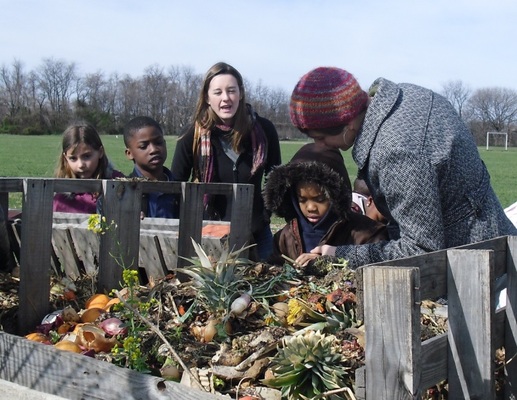
It took three tries for the fifth-grade students from Baltimore City’s Green Charter School to identify a component of Real Food Farm that actually cost the organization money. Tyler Brown, or “Farmer Brown” as he is called by the kids, shared that Whole Foods and other companies deposit their trash at Real Food Farm to serve as composting material. And the wood chips came from a tree company that otherwise would have taken them to the dump. But the hoses, well, those did cost money.
Fueled by Volunteers
Real Food Farm is a project of Civic Works, an organization focused on giving people meaningful opportunities to serve their community. The Knott Foundation has supported Civic Works for a number of years, most recently awarding a $50,000 grant to the Real Food Farm Project in 2010.
From farming, to tutoring and mentoring, to learning how to construct a green, energy-efficient roof, Civic Works acts as a bridge between human capital and community needs. While the majority of volunteers are in the 17-24 age range, the organization also employs elementary-age and senior volunteers, and they come from many different parts of the country.
Building Hoop Houses on Real Food Farm
On a sunny April afternoon amongst fields of freshly planted garlic, onion, carrots, and spinach (and four scarecrows!), a group of high school volunteers from Detroit was helping to build a hoop house. A hoop house is basically a low-cost greenhouse. Real Food Farm has five hoop houses and hopes to grow that number to 20 in the future. The hoop houses allow the Farm to cultivate fruits and vegetables year-round and therefore provide fresh produce to the communities of South Clifton Park, Darley Park, Belair-Edison, and Coldstream-Homestead-Montebello on a regular schedule.
Civic Works recently received a van that will be painted to feature Real Food Farm’s mobile produce market. “The great thing about the Farm is that it not only provides fresh, organic produce to the local community, but it also reduces the transportation costs for the goods and provides an educational platform for kids to see how fruits and vegetables are grown and how they can be prepared in healthy meals,” stated Earl Millett, Director of Volunteer Services.
About Civic Works
Founded in 1993, Civic Works is headquartered in Clifton Mansion, a structure dating back to the late eighteenth century that is still being carefully restored by Civic Works and the Friends of Clifton Mansion. With additional resources, Civic Works plans to further renovate the Mansion in order to enhance its programs. Even Real Food Farm would be able to use a renovated kitchen to expand its cooking classes, since not all residents of the neighborhood are familiar with how to prepare fresh produce and preserve the nutrients.
In the meantime, it seems that Civic Works is still operating at full capacity, and the volunteers just keep calling. So many volunteers, in fact, that Millett explained he sometimes must find alternative opportunities for them with organizations such as Habitat for Humanity, Blue Water Baltimore, Paul’s Place, Baltimore Reads, or Baltimore City Recs and Parks.
If you call and happen to have any garden hoses, however, Civic Works will take them.



 After graduating from Boston College with a degree in business and economics, Codie Perry knew two things: first, he wanted to use his educational background to serve others; and second, he didn’t want to sit in a cubicle all day. Perry applied to Jesuit Volunteer Corps and was placed at St. Vincent de Paul Church in Baltimore City. There, he was charged with running the Church’s outreach ministries in a community experiencing deep poverty.
After graduating from Boston College with a degree in business and economics, Codie Perry knew two things: first, he wanted to use his educational background to serve others; and second, he didn’t want to sit in a cubicle all day. Perry applied to Jesuit Volunteer Corps and was placed at St. Vincent de Paul Church in Baltimore City. There, he was charged with running the Church’s outreach ministries in a community experiencing deep poverty.  “Conservation and repair of our collective cultural heritage is key to our understanding of world history and the universal human need to create,” observes Julie Lauffenburger, Director of Conservation, Collections, and Technical Research. “Works of art that have been preserved and shared with the public help bring history to life and foster conversation about world events, religion, culture, and life in periods beyond our own.”
“Conservation and repair of our collective cultural heritage is key to our understanding of world history and the universal human need to create,” observes Julie Lauffenburger, Director of Conservation, Collections, and Technical Research. “Works of art that have been preserved and shared with the public help bring history to life and foster conversation about world events, religion, culture, and life in periods beyond our own.”  When 30-year old Jasmine moved home to take care of her father with cancer and mother with depression and hoarding issues, she needed someone to help her through the grief, pain, and psychological stress of becoming a caregiver. Enter Pro Bono Counseling Project.
When 30-year old Jasmine moved home to take care of her father with cancer and mother with depression and hoarding issues, she needed someone to help her through the grief, pain, and psychological stress of becoming a caregiver. Enter Pro Bono Counseling Project.  A new, 65,000 square foot school stands proudly on Martin Luther King Jr. Boulevard. A large cross illuminates three stories of windows above the front entrance, which first welcomed students on August 30, 2021.
A new, 65,000 square foot school stands proudly on Martin Luther King Jr. Boulevard. A large cross illuminates three stories of windows above the front entrance, which first welcomed students on August 30, 2021. A clean red brick façade with a statue of St. Veronica helping Jesus, surrounded by manicured green grass and shrubbery, stands proudly on Cherry Hill Road in Baltimore.
A clean red brick façade with a statue of St. Veronica helping Jesus, surrounded by manicured green grass and shrubbery, stands proudly on Cherry Hill Road in Baltimore.  In Baltimore City, a group of red brick row houses sit on West 23rd Street where, in 1968, Sister Irene Marshiano, O.S.F. opened an emergency food and clothing center when local residents told her that’s what they needed most.
In Baltimore City, a group of red brick row houses sit on West 23rd Street where, in 1968, Sister Irene Marshiano, O.S.F. opened an emergency food and clothing center when local residents told her that’s what they needed most.  A 65-year-old woman named Dolores was referred to HASA (formerly known as the Hearing and Speech Agency) by her ENT for hearing aids. She had profound hearing loss. Even though her family knew she needed hearing aids, they could not afford the cost. They came to HASA for help.
A 65-year-old woman named Dolores was referred to HASA (formerly known as the Hearing and Speech Agency) by her ENT for hearing aids. She had profound hearing loss. Even though her family knew she needed hearing aids, they could not afford the cost. They came to HASA for help.  “We give individuals a second chance to take the first step towards a better life,” proclaims Sid Wilson, Executive Director of SBLC/Learning Works.
“We give individuals a second chance to take the first step towards a better life,” proclaims Sid Wilson, Executive Director of SBLC/Learning Works.  The St. Francis Missal is a 12th-century manuscript and beloved to be a relic of touch of St. Francis of Assisi – founder of the Franciscan Friars and the patron saint of Italy, animals, and merchants. The Missal is housed at the Walters Art Museum in Baltimore and was recently exhibited with the support of the Knott Foundation and other funders.
The St. Francis Missal is a 12th-century manuscript and beloved to be a relic of touch of St. Francis of Assisi – founder of the Franciscan Friars and the patron saint of Italy, animals, and merchants. The Missal is housed at the Walters Art Museum in Baltimore and was recently exhibited with the support of the Knott Foundation and other funders.  “One great thing about the library is that it’s a place people trust,” comments Meghan McCorkell, Marketing Director of the Enoch Pratt Free Library, “so they feel comfortable coming to us for help.”
“One great thing about the library is that it’s a place people trust,” comments Meghan McCorkell, Marketing Director of the Enoch Pratt Free Library, “so they feel comfortable coming to us for help.” “Our mission is the spread the Word of God and be the Light of Christ for the Essex community in this day in time,” proclaims Father Richard Gray, Pastor of St. Clare Parish in Baltimore County.
“Our mission is the spread the Word of God and be the Light of Christ for the Essex community in this day in time,” proclaims Father Richard Gray, Pastor of St. Clare Parish in Baltimore County. “It’s so great to see the kids watching the new gym being built,” observes Sister Peggy Juskelis, President of Mother Seton Academy. “They see this as a sign of people’s belief in them. To the kids, it’s not just a steel structure, it’s a symbol of the great promise the future holds and the transformative effect of education.”
“It’s so great to see the kids watching the new gym being built,” observes Sister Peggy Juskelis, President of Mother Seton Academy. “They see this as a sign of people’s belief in them. To the kids, it’s not just a steel structure, it’s a symbol of the great promise the future holds and the transformative effect of education.” A class of kindergartners from James McHenry School walks out of the B&O Railroad Museum abuzz with excitement. As the first school group to tour the First Mile Stable – an innovative partnership between the Museum and the Baltimore City Police Department – the children had spent the morning meeting horses and talking to Sargent Russ Robar, the head of the City’s Mounted Police Unit.
A class of kindergartners from James McHenry School walks out of the B&O Railroad Museum abuzz with excitement. As the first school group to tour the First Mile Stable – an innovative partnership between the Museum and the Baltimore City Police Department – the children had spent the morning meeting horses and talking to Sargent Russ Robar, the head of the City’s Mounted Police Unit. How do you double your grant revenue in a year by applying for fewer grants? Ask the
How do you double your grant revenue in a year by applying for fewer grants? Ask the  Situated in the Edmondson Village neighborhood of West Baltimore, St. Bernardine Catholic Church has a storied history. As one of the largest Catholic parishes in the City in the 1950s, it nearly closed 20 years later when it struggled to adapt to changing demographics and a changing Catholic Church.
Situated in the Edmondson Village neighborhood of West Baltimore, St. Bernardine Catholic Church has a storied history. As one of the largest Catholic parishes in the City in the 1950s, it nearly closed 20 years later when it struggled to adapt to changing demographics and a changing Catholic Church.  “Ships are safe in harbor, but that’s not what ships are built for,” says Leanna Powell, Fundraising Manager at Baltimore Chesapeake Bay Outward Bound School.
“Ships are safe in harbor, but that’s not what ships are built for,” says Leanna Powell, Fundraising Manager at Baltimore Chesapeake Bay Outward Bound School.  When Macy showed up at Charm City Care Connection’s clinic in East Baltimore, she wanted help getting medical insurance coverage. The case management team signed her up for Medicaid and reconnected her with her primary care doctor. They also recommended she do some preventative health screenings their medical team was offering that day – which was how they found her blood pressure was dangerously high.
When Macy showed up at Charm City Care Connection’s clinic in East Baltimore, she wanted help getting medical insurance coverage. The case management team signed her up for Medicaid and reconnected her with her primary care doctor. They also recommended she do some preventative health screenings their medical team was offering that day – which was how they found her blood pressure was dangerously high.  When he’s not running the Front of House at
When he’s not running the Front of House at  “It’s my heart and soul, and the most phenomenal place I’ve ever worked,” declares Mandy Arnold, President & CEO of
“It’s my heart and soul, and the most phenomenal place I’ve ever worked,” declares Mandy Arnold, President & CEO of  A list of rules sits on every table in Druid Heights Community Development Corporation, where a group of approximately 20 young people are gathered afterschool. “Be respectful to everyone,” and “don’t destroy things” are two points on the list. “The kids came up with these rules themselves,” explains Anthony Pressley, Executive Director, “so they’re worded the way they would talk.”
A list of rules sits on every table in Druid Heights Community Development Corporation, where a group of approximately 20 young people are gathered afterschool. “Be respectful to everyone,” and “don’t destroy things” are two points on the list. “The kids came up with these rules themselves,” explains Anthony Pressley, Executive Director, “so they’re worded the way they would talk.” When Melvin came to Joseph Richey Hospice, he likely did not expect a party thrown in his honor. It turns out Melvin loved to fish, and he often spoke to the hospice staff about taking a fishing trip before he reached the end. When a trip with a friend fell through, the staff decided to take matters into their own hands: they threw a fishing party for Melvin in the backyard of the house, complete with a kiddie pool, fishing poles, and party hats.
When Melvin came to Joseph Richey Hospice, he likely did not expect a party thrown in his honor. It turns out Melvin loved to fish, and he often spoke to the hospice staff about taking a fishing trip before he reached the end. When a trip with a friend fell through, the staff decided to take matters into their own hands: they threw a fishing party for Melvin in the backyard of the house, complete with a kiddie pool, fishing poles, and party hats.  Four out of five people who leave the Catholic Church do so between the ages of 18 and 23. Meanwhile, the American College Health Association routinely reports widespread unhappiness among college students in this age range. So how does the Church find those who are lost and ultimately show them a path to a more fulfilling life?
Four out of five people who leave the Catholic Church do so between the ages of 18 and 23. Meanwhile, the American College Health Association routinely reports widespread unhappiness among college students in this age range. So how does the Church find those who are lost and ultimately show them a path to a more fulfilling life? “While the number of children in foster care is declining in Maryland, the number in Allegany County has nearly doubled over the last four years, largely due to the drug epidemic,” says Misty Raines, Executive Director of CASA of Allegany County. Citing one of many examples, Raines shares the story of a young mother in Cumberland who recently died from an overdose, leaving her two young children with no options other than foster care.
“While the number of children in foster care is declining in Maryland, the number in Allegany County has nearly doubled over the last four years, largely due to the drug epidemic,” says Misty Raines, Executive Director of CASA of Allegany County. Citing one of many examples, Raines shares the story of a young mother in Cumberland who recently died from an overdose, leaving her two young children with no options other than foster care.  As one of the region’s larger human service organizations,
As one of the region’s larger human service organizations,  Special deliveries arrive each day at University of Maryland St. Joseph Medical Center: more than 2,200 babies are born at the Catholic hospital in Towson every year.
Special deliveries arrive each day at University of Maryland St. Joseph Medical Center: more than 2,200 babies are born at the Catholic hospital in Towson every year.  “One of the things we always say is, ‘If you can’t read, you can’t do anything,’” states Marcy K. Kolodny, CEO of the
“One of the things we always say is, ‘If you can’t read, you can’t do anything,’” states Marcy K. Kolodny, CEO of the  Fifteen new employees – all formerly homeless youth – are seated in an art studio for their new job orientation. “This is not just about making art. It’s about job readiness,” says the orientation director. She explains that they will be learning many different artistic techniques throughout their employment, but if they are late for work by only ten minutes, they will not get paid that day. “Punctuality is important on the job, and docking your pay may seem harsh, but at least you keep your job.”
Fifteen new employees – all formerly homeless youth – are seated in an art studio for their new job orientation. “This is not just about making art. It’s about job readiness,” says the orientation director. She explains that they will be learning many different artistic techniques throughout their employment, but if they are late for work by only ten minutes, they will not get paid that day. “Punctuality is important on the job, and docking your pay may seem harsh, but at least you keep your job.”  “It is a gift to be a part of an international order. You can’t be on the side of the poor only in your head. To have their firsthand experience is just such a gift and very moving,” reflects Sr. Carol Lichtenberg, SNDdeN, Provincial of the Ohio Province for the Sisters of Notre Dame de Namur.
“It is a gift to be a part of an international order. You can’t be on the side of the poor only in your head. To have their firsthand experience is just such a gift and very moving,” reflects Sr. Carol Lichtenberg, SNDdeN, Provincial of the Ohio Province for the Sisters of Notre Dame de Namur.  “What we strive for on stage is truth – finding a way to present something that is authentic,” proclaims Jonathan K. Waller, Managing Director of Everyman Theatre in Baltimore.
“What we strive for on stage is truth – finding a way to present something that is authentic,” proclaims Jonathan K. Waller, Managing Director of Everyman Theatre in Baltimore.  When Marian House opened its doors 33 years ago, their vision was to provide a brighter future to homeless women coming out of the prison system. Today, while Marian House has expanded to serve homeless women coming from multiple avenues, that vision has stayed true: to transform society by unlocking the potential of women who need a supportive place to live and heal.
When Marian House opened its doors 33 years ago, their vision was to provide a brighter future to homeless women coming out of the prison system. Today, while Marian House has expanded to serve homeless women coming from multiple avenues, that vision has stayed true: to transform society by unlocking the potential of women who need a supportive place to live and heal. When a single mother whose six-year-old son was in need of inpatient mental health services in Hagerstown and there was no bed available at Brook Lane, the child and his mother were taken by ambulance to the next nearest in-patient facility, 75 miles away. Once the child was admitted there, the mother had to find affordable transportation back to Hagerstown, and then negotiate trips back and forth to Baltimore to be with her child, all while keeping her job.
When a single mother whose six-year-old son was in need of inpatient mental health services in Hagerstown and there was no bed available at Brook Lane, the child and his mother were taken by ambulance to the next nearest in-patient facility, 75 miles away. Once the child was admitted there, the mother had to find affordable transportation back to Hagerstown, and then negotiate trips back and forth to Baltimore to be with her child, all while keeping her job. Living up to the organization’s tag line to “inspire, empower, nurture, succeed,”
Living up to the organization’s tag line to “inspire, empower, nurture, succeed,”  Standing in front of the new Fire Alarm Office at the
Standing in front of the new Fire Alarm Office at the  Caring and nursing are synonymous in our society. Yet to be caring specialists for patients, nurses need a support system of their own. That is how the Grow Your Own program at
Caring and nursing are synonymous in our society. Yet to be caring specialists for patients, nurses need a support system of their own. That is how the Grow Your Own program at  “Sacredness is a big part of why people like to come to Mother Seton’s Shrine,” says Rob Judge, Executive Director of the
“Sacredness is a big part of why people like to come to Mother Seton’s Shrine,” says Rob Judge, Executive Director of the  Turning 18 is a rite of passage for any young person, but it can be especially perilous for those in foster care.
Turning 18 is a rite of passage for any young person, but it can be especially perilous for those in foster care. Sometimes we forget the importance that Baltimore plays in this nation’s history… and sometimes we can forget the role that museums, like the Star Spangled Banner Flag House, play in reminding us of this history.
Sometimes we forget the importance that Baltimore plays in this nation’s history… and sometimes we can forget the role that museums, like the Star Spangled Banner Flag House, play in reminding us of this history. Since 1991,
Since 1991,  Love is shown more in deeds than in words,” St. Ignatius wrote. Today, the
Love is shown more in deeds than in words,” St. Ignatius wrote. Today, the  Words like “variable data printing” and “tray sequence numbers” are standard vocabulary at League Industries, a program of
Words like “variable data printing” and “tray sequence numbers” are standard vocabulary at League Industries, a program of  How many young people can calculate the value of a stock portfolio or define the difference between gross and net income? Nine in ten Catholic school seventh and eighth graders could, after participating in
How many young people can calculate the value of a stock portfolio or define the difference between gross and net income? Nine in ten Catholic school seventh and eighth graders could, after participating in  Some students use the classroom computer to print their homework because they don’t have a printer at home. Others need the computer for assistive technology to accommodate their learning needs. And yet others might use it to access an online dictionary and challenge a friend’s word during a heated Scrabble game. In all cases, students at
Some students use the classroom computer to print their homework because they don’t have a printer at home. Others need the computer for assistive technology to accommodate their learning needs. And yet others might use it to access an online dictionary and challenge a friend’s word during a heated Scrabble game. In all cases, students at  What does it mean to be a Red Devil?
What does it mean to be a Red Devil? In 2004, four congregations of religious women came together to respond to the community’s call for an all girls’ tuition-free middle school in southwest Baltimore. The result was
In 2004, four congregations of religious women came together to respond to the community’s call for an all girls’ tuition-free middle school in southwest Baltimore. The result was  “To live – that’s really what we’re about. We don’t focus on the dying. We focus on enjoying what time remains,” declares Brenda Blunt, Gilchrist Kids Program Manager.
“To live – that’s really what we’re about. We don’t focus on the dying. We focus on enjoying what time remains,” declares Brenda Blunt, Gilchrist Kids Program Manager.  On the day of First Holy Communion, friends and family of the
On the day of First Holy Communion, friends and family of the  52,000 labor hours created. $3.2 million consumer dollars saved. 11 million pounds of landfill waste diverted. And that was just in one year!
52,000 labor hours created. $3.2 million consumer dollars saved. 11 million pounds of landfill waste diverted. And that was just in one year! You might see them in chest waders scooping debris out of the lake with pool skimmers. Or mulching trees. Or inspecting playground equipment for safety. In all cases, the
You might see them in chest waders scooping debris out of the lake with pool skimmers. Or mulching trees. Or inspecting playground equipment for safety. In all cases, the  Feeding Those in Need
Feeding Those in Need When Shawn came to
When Shawn came to 